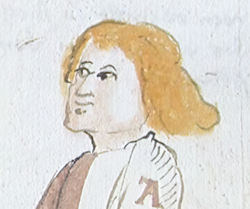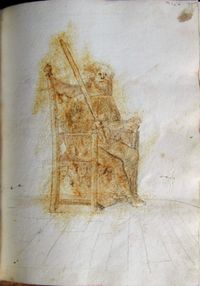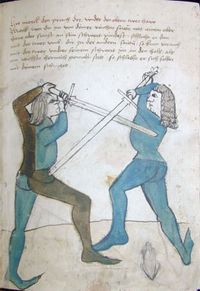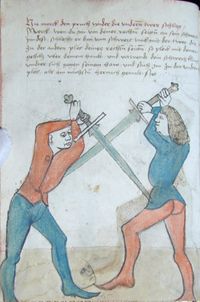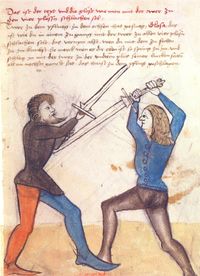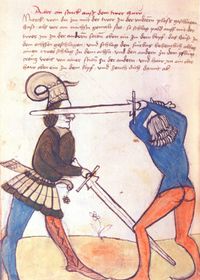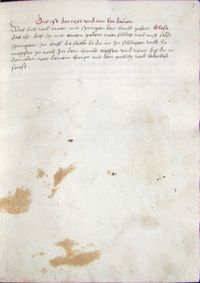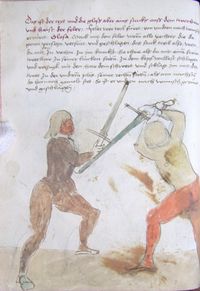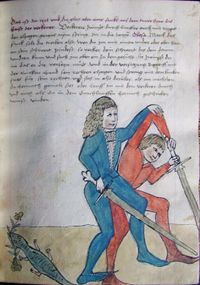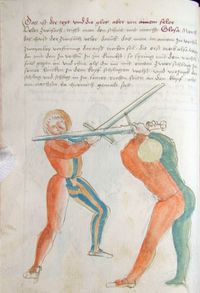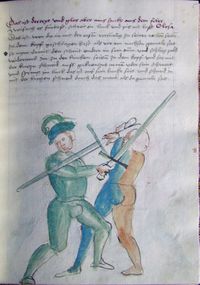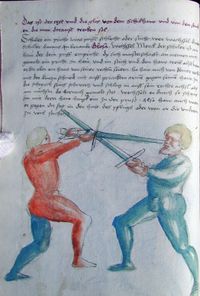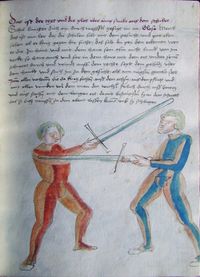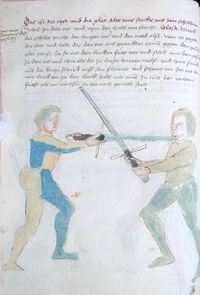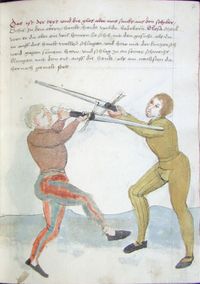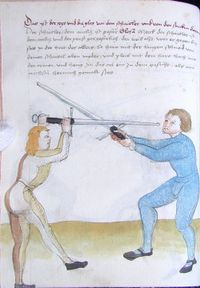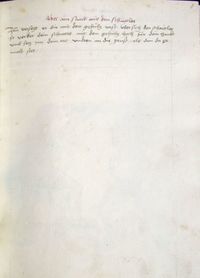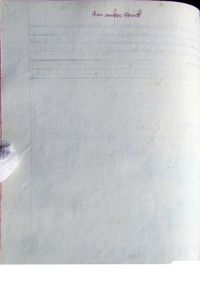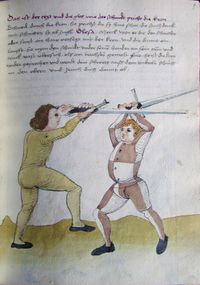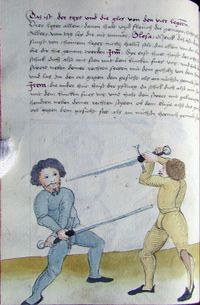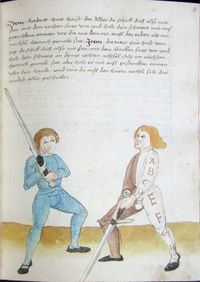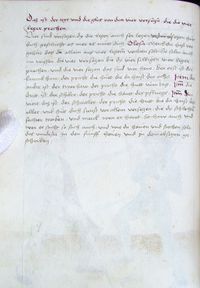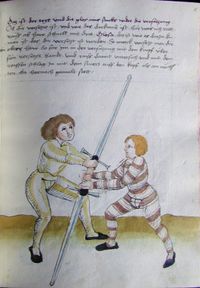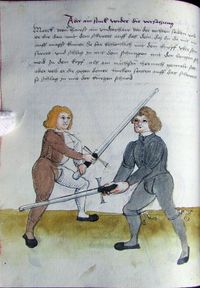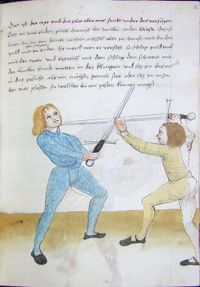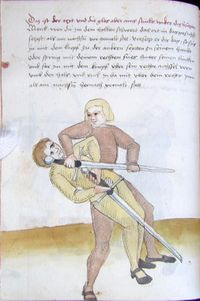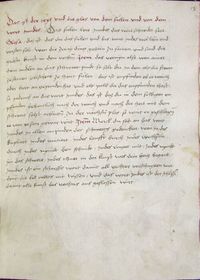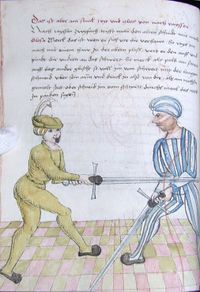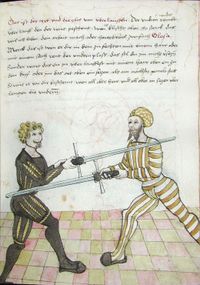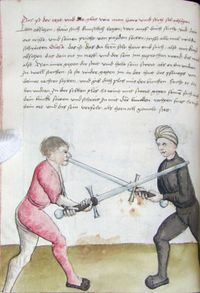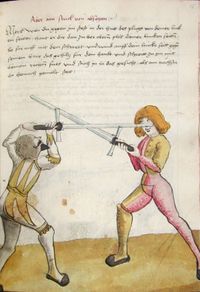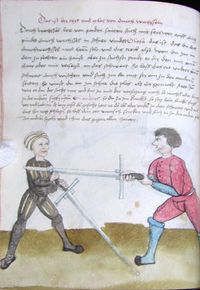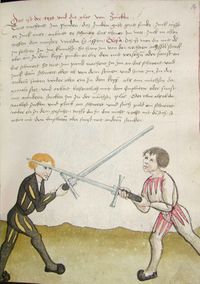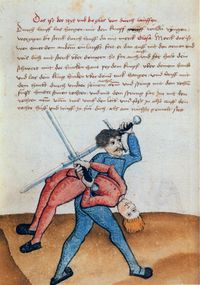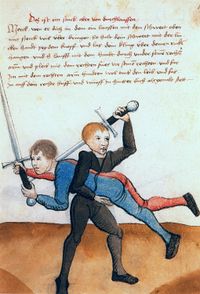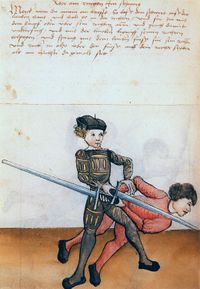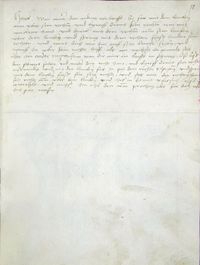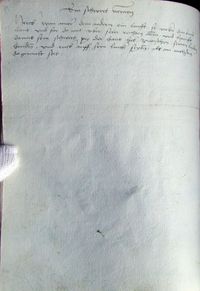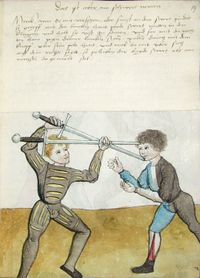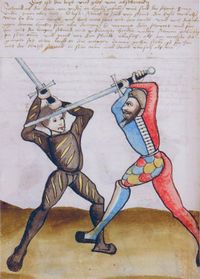Images
|
Translation (from the Dresden) 
by Keith Farrell
|
Dresden Transcription (1504-19) [edit]
by Dierk Hagedorn
|
Glasgow Transcription (1508) [edit]
by Dierk Hagedorn
|
Rostock Transcription (1563-71) [edit]
by Dierk Hagedorn
|
|
|
[1] Here begins the explanation of the epitome.
In which lies recorded the knightly art of the longsword, composed and formed by Johannes Liechtenauer, who was a great master in the art, may God be merciful to him. He wrote the markverses with deep and hidden words, so that the art would not be widely known. And these deep and hidden words have been by Master Sigmund ain Ringeck, fencing master to the highborn prince and noble Lord Albrecht, Count Palatine of Rhine and Duke of Bavaria, recorded and explained in this little book which now follows, so that every fighter who otherwise can fight, shall be able to take these and understand them.
|
[010v] Hie hept sich an die vßlegu~g der zedel
In der geschriben stett die Ritterlich kunst des langes schwerts Die gedicht vnd gemacht hat Johannes lichtenawer der ain grosser maiste~ in der kunst gewesen ist dem gott genedig sÿ der hatt die zedel laußen schrÿbe~ mitt verborgen vñ verdeckte~ worten Daru~b dz die kunst nitt gemain solt werde~ Vnd die selbige~ v°borgneñ vñ verdeckte wort hatt maister [011r] Sigmund ain ringeck der zÿt des hochgeborne~ fürsten vñ herreñ herñ aulbrecht pfalczgrauen bÿ Rin vñ herczog in baÿern schirmaiste~ Glosieret vñ außgelegt alß hie in disem biechlin her nach geschrÿben stät dz sÿ ain ÿede~ fechter wol verömen vnd vestan mag der da ande~st fechten kan etc~ ~
|
[022r] Merck die zettl /
dar in geschribñ stett / die kunst des langen schwerch die Johannes liechtñawen hat lassen schreiben mit verporgen vnd verdachtñ wortñ / die w selbigñ wort hat Maist~ Sigmund Emring verklert vnd aus gelegt / als In[4] diessem puech geschribñ stett vnd gemalt / vnd hat das gethon daru~b daz fu~rstñ vnd herrñ Ritter vnd knecht den die kunst zu gehõrt dester grosser lieb darzu habñ su~llen Anno dm~ 1508
|
[006r] Hie hebẽ sich an die Zedttel
In den geschrieben stedt die Ritterlich kunst, des langen schwerdts die gedicht vnnd gemacht hat Johannes Liechtennaur der ein großer meister In der kunst gewesen ist. Dem gott gnedig sey, der hatt die Zedtel lasen schreiben mitt verborgen vnd verdackten wortten, darumb das die kunst nicht gemeyns solt werden, vnd dieselbigen verborgen vnd verdagkten worten der Zedtel, Die hat meister Sigmundt Einring zu derselbigenn zeit des hochgeboren fursten vnd herren herren Albrechts Pfaltzgraff bey Rein vnd hertzog in Bayernn schiermeister gewesen ist, also glossirt vnnd ausgelegtt, als sie den in diesem buchlein hernach geschrieben, vnd gemalt stehnn, das sie ein Jeder fechter wol vernemen vnd verstehen mag, der da anderß recht fechten kan.
|
|
|
[2] Foreword to the epitome.
|
|
Young knight, learn
to always honour women, and love God,
so increase your honour.
Practice chivalry and learn
arts which improve you
and in the battle bring honour.
Wrestle well, understand the lance,
spear and sword and use the knife
like a man.
Cut fiercely!
Storm forwards: Hit or miss;
The well-experienced hate that
which seeks to cut them.
This you shall understand:
all arts have length and measure.
|
|
Die vor red der zedel ~
Jungk ritter lere
Got liebhaben fröwen ia ere
so wöchse dein are ere
Kunst die dich ziert
In kriegen zu° ern hoffiert
[011v] Ringes gütt fesset
Glefen sper schwert vnd messer /
manlich bederben
Haw drin hart dar
Rausch hin triff ode~ las farñ
daß in die wÿsen /
hassen den man sicht brÿsen
Daruff dich fasse /
alle kunst haben lenge vñ masse ~~~ ·:·~
|
|
Das Ist die vorredt.
Junckh Ritter lere
got lieb haben, frauen so ehre
so wechst dein Ehre
vber Ritterschafft vnd lehre
kunst, die dich ziertt
vnd In kriegen Zw ehren hoffirt,
Ringens gut Fesser
Gleffen Spern schwerdt vnd messer
manlich bederben,
vnnd In andern henden verderben,
Haw drein, vnnd huet dar
rausch hin trieffe oder laß farenn
das in die weissen
hasen, den man sicht preisn
darauff dich fasse,
alle kunst hab ein leng vnd masse.
|
|
|
[3] Many good general lessons about the longsword.
|
|
If you would like to see skill,
see that you go to the left then right with the cuts.
And left with right,
if you want to fight strongly.
|
Glosa This is the longsword's first lesson; that you shall learn to cut properly from both sides, so that you can fight strongly and correctly. When you want to cut from the right side, stand with your left foot forwards; and when you want to cut from the left side, stand with your right foot forwards. If you cut with an Oberhau from the right side, follow after the cut with your right foot. If you do not do this then the cut is poor and insincere, because your right side lingers behind. Then the cut becomes too short and cannot follow the correct arc down towards the other side, in front of the left foot.
|
Das ist der text von vil gu°tter gemainer lere des langen schwerts
Willtu kunst schowen
Sich linck gen vñ recht mitt hawen
Vñ linck mitt rechtem /
ist dz du starck gerst fechten :·
Glosa Merck dz ist die erst lere des [012r] langes schwercz dz du die hew võ baÿden sÿtten recht solt lernen hawen Ist dz du annders starck vñ gerecht fechten wilt Dz ver nÿm allso Wenn du wilt howe~ von der rechten sÿtten So sich dz dein k lincker fu°ß vor stee Vñ wenn du wilt howe~ võ der lincken sÿtten so sich dz dein rechter fu°ß vor stee Haw Häustu dann den ober haw° von der rechten sÿtten so folg dem haw nach mitt dem rechten fu°ß tu°st du dz nicht / so ist der how falsch vnd vngerecht wann dein [012v] rechte sÿten pleibpt dahinden Daru~ ist der haw zu° kurcz vñ mag sein rechten gang vndersich zu° der rechten sÿten andere~ sÿtten vor dem lincken fu°ß nicht gehaben
|
|
[006v] Das ist der Textt von viel gutten gemeinen lere des lang~ schwerdts.
Wiltu kunst schauen
sich lingck gehen vnd recht mit hauen
vnd ling mitt rechten
ist das du strackh [sic] begerst fechten.
Glosa. Merck das ist die erste lere des langen schwerdts, das du die hew von beyden seitten recht solst lernen hauen, Ist das du anderst starck vnnd gerecht fechten wilt, das vernym also wen du wilt hauen, von der rechten seiten, so sich das dein lingker fueß vorstee, vnnd wen du wilt hauen, von der lincken seytten so sich das dein rechter fuß vorstee, hastu dan den vberhaw von der rechten seiten, so volge dem haw nach, mit dem rechten fuß, thustu das nicht so ist der haw falsch vnd vnrecht, wenn dein rechte seiten bleibet dahinden, darumb ist der haw zw kurtz vnd mag seinen rechten ganng vnder sich zw der andernn seiten vor dem lincken fueß nicht gehaben,
|
|
|
Similarly the cut is incorrect if you strike from the left side and do not follow after the cut with the left foot. So mark well, from which side you strike, that the foot follows after the cut. In this manner you can perform all of your techniques correctly and with strength. And in the same way should all the other cuts be performed.
|
Des glÿchen wenn du haw°st von der lyncken sÿtten vnd dem haw nicht nachfolgest mitt dem lincken fu°ß so ist der haw° och falsch Daru~ so merck von welcher sÿtten du haust / dz du mitt dem selbige~n fu°ß haw° nachfolgest so magstu mitt sterck alle dein stuck gerecht trÿbeñ Vnnd also süllen alle andere hew° [013r] och gehawen werden ~:·
|
|
deßgleichen wen du haust von der lincken seiten, vnd dem haw nicht nach volgest mit dem lincken fueß, So Ist der haw auch falsch, Darumb so merck von welcher seitten du hawest, das du mit dem selbig~ fueß, dem haw nachvolgest, so magstu mit stercke alle deine stucke gerecht treiben, vnd also sollen all ander hew auch gehauen werdenn.
|
|
|
[4] A further lesson.
|
|
He who goes after the cut,
receives little joy from his skills.
Cut closely, then do what you want
so he cannot to change-through your defence.
Strike to the head, to the body,
do not refrain from swift strikes.
Fence with the whole body
if you want do this with strength.
|
Glosa When you come against him in Zufechten you shall not await his attack, and neither shall you wait to see what he is thinking about doing to you. All fencers who are hesitant and wait for the incoming attack, and do nothing other than to ward it away, they gain very little joy from this sort of practice because they are often beaten.
|
Der text aber võ aine~ lere
Wer nach gat haw°en /
der darff sich kunst wenig fröwen
Haw nachent waß du wilt
kain wechsel kumpt in dein schilt
Zu° koppff zu° lÿbe /
die zeck nicht vermÿde /
mitt ganczem lÿb
ficht waß du strarck gerst zu° trÿben :·
Glosa Wenn du mitt dem zu°fechten zu° im kumpst so solt du vff sein hew nicht sechen noch warten wie er die gegen dir trÿbt wann alle fechte~ die do sechen vñ warten vff aines anderen hew Vnnd wellend anderß nichtß nicht~ thon [013v] dañ verseczen die durffen sich söllicher kunst wenig fröwen wann sÿ werden do bÿ offt geschlagen
|
|
Der Textt aber von einer Lehre
Wer nach gehet hauen
der darff sich kunst nicht frewen
Haw nahet was du wilt,
kein wechseler kombt an den schildt
zw kopff zw leib
die zeckrur nicht vermeydt,
mit gantzem leyb
ficht was du starck begerest zw treybenn.
[007r] Glosa. Mercke das ist wen du mit dem zufechten zw im kumbst, so soltu auff sein hew nicht sehen auch noch wartten, wie ehr die gegen dir treybtt wenn alle fechter die da sehen vnd wartten, vff eines andern hew, vnnd wöllen anderst nicht thun, wen versetzen die bedurffen sich solcher kunst wenig freuen wann sie werden dabey offtt geschlagen.
|
|
|
Always fight with the strength of the whole body! Cut close into him, to the head and to the body, so he cannot change-through in front of your point. And when the cut ends up in the bind you shall not hesitate but shall quickly and fluently make attacks against the nearest opening, using the five strikes and other techniques that will be described later.
|
Item du solt mercken alles dz du fechten wilt dz trüb mitt ganczer störck deines lÿbs Vnnd haw im do mitt nahent ein zu° kopff vñ zu° lÿb so mag er vor dinem ort nicht durch wechslen Vñ mitt dem haw° solt du im den anbinden des schwerts der zek zeckru°re nicht vermyden zu° der nächsten blöß di dir hernach in den fünff hewen vnd in anderen stucken vßgericht [014r] werden ~~ :·
|
|
Item merck alles was du fechten wilt, das treib mitt gantzer sterck deines leybes, vnnd haw im damit nahẽt zw dem kopff, vnd zu dem leyb, So mag ehr von deinem ort nicht durch gewechselnn vnd mit dem haw soltu in dem anbinden des schwerdts der Zweck rur nicht vermeydenn zẅ der negsten blöße die dir hernach in denn funff hewenn vnd In andern stucken ausgericht werdenn.
|
|
|
[5] Another lesson.
|
|
Hear what is bad,
do not fence from the left if you are right-handed,
and if you are left-handed,
you are weak from the right.
|
Glosa This lesson applies to two types of people: those who are left-handed and those who are right-handed. When you come against him in Zufechten, if you are right-handed and want to strike him, you must not throw your first cut from your left side. That is because this is weak and cannot bring strength to bear if he binds the strong of his blade against you. Therefore, cut from your right side, so you can be strong and skillful in the bind and can do as you will. Similarly, if you are left handed, do not cut from the right, because the art is pointless when a left-hander tries to fence from the right side. Likewise this statement applies to a right-hander fencing from the left side.
|
aber ain lere
Höre waß du schlecht ist /
ficht nitt oben linck / so du recht bist
Vñ ob du linck bist
Im rechte~ auch ser hinckest ·:
Glosa Mörck die lere trifft an zwu° personen aine~ lincken vnd ain grechten / vñ mainest den man zu° schlagen So haw° den ersten haw° Das vernÿm also. Wann du mitt zu° fechten zu° im kumpst Bist du dann gerecht vñ mainest den man zu° schlachen So haw den erste~ haw° nicht von der lingen sÿtten Wann der ist schwach vnd magst damitt nicht
[014v] wider gehalten wann man dir starck daruff bindt Darum so haw der rechten sÿtten / so magst du starck am schwert mitt kunst arbaÿten waß du wilt
Des gelichen Bist du linck so haw° och nitt von der rechtt~ wenn die kunst ist gar wild aine~ lincken ze triben von der rechten sÿtten Des glich ist es och aine~ rechten von der lincken sÿtten ~
|
|
Aber ein lehre.
Hor was da schlecht ist
ficht nit oben lingck so du recht bist,
vnd ob du lingck bist
im rechten auch sere hinckest,
Glosa. Merck die lehre trifft an zwo p~son einem lingcken vnd einem rechten, vnd das vernym also wen du mit zufechten zw im kumbst, bistu den gerecht, vnd meinst, den man zu schlagen, so haw den ersten haw nicht, von der lincken seyten wan ehr ist schwach vnd magst damit nit wyderhalten wan man dir starck darauff bindt darumb so haw von der rechten seiten so magstu starck am schwerd mit kunst arbeiten was du wilt,
|
|
|
[6] A lesson about "Before" and "After".
|
|
"Before" and "After", these two things,
all other skills spring from these.
"Weak" and "Strong",
"Instantly", mark well these words.
So you can learn
to work skillfully and defend yourself.
If you become gentle and timid,
you will never learn anything about fencing.
|
Glosa Mark well that more than anything else you must understand "Before" and "After", because these two concepts are the grounding from which all fencing comes.
|
Daß ist der text vñ lere ain lere von vor und nach
Vor vñ nach die zwaÿ dinck /
sÿnd aller kunst ain vrsprimg
Schwöch vñ störck
/In/des/ daß wort domitt mörck
So magst [015r] du leren
mitt kunst arbaiten vñ wereñ
Er schrickstu gern /
kain fechten nim~er lern gelerñ ·:
Glosa Merck dz ist dz du vor allen sachen wol solt verston daß vor und daß nach / wann die zwaÿ ding sind ain vrspru~g do alle kunst des fechtenß außgät Daß vernÿm also Daß for das vor daß ist dz du all weg solt vorkum~en mitt aine~ haw° ode~ mitt aine~ sch stich Im zu° der blöß Ee wann er dir zu der deinen so mu°ß er dir verseczen / so arbaÿt in der versachung behentlich für dich mitt dem schwert
|
|
|
|
|
[7]
Mark also: "Before" means that you shall always perform a strike or thrust against his openings, before he does the same to you. Then he must defend against you! And work deftly both in the defence and in moving your sword from one opening to another, so he cannot have the chance to perform his own techniques between yours. But if he rushes in close to you, deal with him through wrestling.
|
[015v] von ainer be blöß zu° der andere~ so mag er vor deiner arbaÿt zu° seine~ stucken nicht kom~en Aber laufft er dir ein eÿnn So kom~e fo vor mitt dem ringen ~~~≈~~~~~~~
|
|
|
|
|
[8] Mark, that which is called "After".
Mark, that if you cannot come in the "Before", wait for the "After". This will defeat all techniques that he does against you. When he comes at you so that you must defend yourself against him, so work deftly "in the Instant" with your defence against his nearest opening, so strike him before he can finish his technique. Thus you win the "Before" and he is left in the "After". You shall also know how you can use "the Instant" against his "weak" and "strong" parts of the sword.
|
Hie mörck was da haÿsst daß nach
Mörck magstu zu° dem vor nitt kom~en So wart uff dz nach dz sÿnd die brüch uff allen stu°ck die er vff dich trÿbt Das vernÿm also Wann er vorkumpt daß du ihm verseczen mu°st So arbait mitt der versäczung / Indes behentlich für dich zu° der nächsten blöß So triffestdu in ee Wann [016r] er sein stuck verbringtt
Also gewinstu aber dz f vor Vñ er blÿpt nach Auch soltu in dem vor vñ nach mörcken wie du mitt wort /in des/ arbaitten solt nach der schwech vnd nach der störck seines schwertß Vnd das vernÿm Also Von dem gehulcze des schwerts by biß in die mitten der clingen Hatt dz schwert fin sin störcke dar mitt du wol magst wide~ gehalten wann man dir dar an bindt Vñ fürbaß von der mitt biß an den ort hat es sein schwöch da magst nitt nicht wider
|
|
|
|
|
[9]
From the hilt of the sword to the blade's centre the sword is "strong", and with this you can meet against his blade when you bind against it. And further, from the middle to the point the sword is "weak", which should not be brought against his blade. And when you really understand these things you can work skillfully and defend yourself well, and later teach princes and lords, so that they with these same skills can protect themselves well in play and earnest. But if you become frightened easily you should not learn fighting arts, because a weak and frightened heart—it does not help you—it defeats all of your skills.
|
[016v] gehalten Vñ wenn du die ding recht verstest So magstu mitt kunst wol arbaitten vñ dich darmitt wören vñ fürbaß lerne~ fürsten vñ her~eñ dz sÿ mitt der selbige~ kunst wol mügen besten In schim~pff vñ in ernst Aber erschrckstu gern so saltu die kunst des fechtens nitt lerne~ Wann ain blöds verzags hercz dz tu°t kain gu°t wann es wirt bÿ aller kunst geschlagen ~ ~ ~
|
|
|
|
|
[10] The Five cuts.
|
|
Learn five cuts from the right hand.
He who can defend himself with these,
he should be praised,
his skill rewards him well.
|
Glosa Mark well, the teaching verses present five secret cuts, which many swordmasters do not know to speak about. You will learn not to strike any other cuts when you come from the right side against one who stands against you in defence. And try if you can to hit an opponent with the first strike using one of these five cuts. The one who can counter with these against an opponent without being hurt will be praised by the master of the markverses, and his skill shall reward him more than another fencer who cannot fence with the five cuts. And how you shall throw the five cuts you will find hereafter recorded in the verses that talk about these same five cuts.
|
Der text võ den fünf hewen
Fünff hew° lere
von der [017r] rechten hand Wer dz wäre
dem wir geloben /
in kunsten gern zu° lonen ~:·
Merck die zedel seczt fünff verborgne hew° Da von vil maiste~ des schwerts nicht wissen zuo zu° sagen Die soltu anders nicht lerne~ hawen wann võ der rechten sÿtten gege~ dem der sich gegen dir stöllet zu° der were Vñ versu°ch öb du mitt aine~ haw vsß den fünffen den man mitt dem ersten schlag mügest treffen Wer dir die brechenn kan on seine~ schaden / so wirt im gelopt Von dem maiste~ der zedeln daß im siner kunst [017v] bas gelonet soll werde~ dann aine~ andern fechtern der wÿde~ die funff hew nicht fechten kann Vñ wie du die fünff hew howen solt / dz fündest du in den selbigen funff hewen her nach geschriben /
|
|
[007v] Das ist der Text von denn funff hewenn.
Funff hewe lehre
von der rechten hanndt wyde[r] die wehre
dem wir geloben
in kunsten geren zu lohnn.
Glosa. Merck die zedtel setz verbo[r]gen hew daruon viel meister des schwerdts nit wissen zu sagen die soltu anderst nicht lerne[n] hauen wan von der rechten seytten gegen de[n] der sich gegen dir stellet zur wehre vnnd ve[r]such ob du mitt einem haw aus denn funff[?] den man mit dem ersten schlag mugst treffe[n] wer dir die brechen kan, an sein schaden den soll wirt gelobett vonn dem meister der zetel da[s] im sein kunst böß gelonet sol werd~, wen einem anndernn fechter der wider die funff haw nit fechtenn kann, vnnd wie du die funf hew hawen solt, das vindestu hernach geschribenn.
|
|
|
[11] The techniques of the markverses.
|
|
Wrath strike, crooked strike, crosswise,
squinting, with Parting
breaking the Fool,
follow after, go over,
cut, change through, twitch,
rush in, slice, press the hands,
hanging guard, and with openings,
strike, catch, sweep and thrust with the point.
|
Glosa Here are listed the correct and most important techniques in fighting with the longsword, they are named specifically so that you may understand them better. They are seventeen in number and begin with the five cuts.
|
Das ist der võ den stucken de~ zedeln
Zorn haw · krump · zwerch
hat Schiller / mitt schaittler
Alber verseczt /
nachraÿsen Vberlauff hav haw seczet
Durch wechsel zuck
durch lauff abschnide / hende dn druck /
heng vñ mitt blössen
schlach vach streÿch sch stich mitt stossen ~·:·~
Glosa [018r] Mörck hie werden genampt die rechten haüptstucke der kunst deß langen schwerts wie ÿettlichs besunde~ haist mit dem namen / daß du die dester baß ver sten kündest Der ist sibenzechen an der zal Vnd heben sich an den funff hewen an / ~~ Item num nun mörck der erst haw haist der zorn haw
Der ander der krump haw
Der drit der zwer haw
Der viert der schill haw
Der funfft der schaittel/haw
Der sechst daß sind die vier
|
|
|
|
|
The first cut is called the wrath strike,
the second is the crooked strike,
the third is the crosswise strike,
the fourth is the squinting strike,
the fifth is the parting strike,
the sixth: these are the four guards,
the seventh is the four displacements,
the eighth is travelling after,
the ninth is the over reaching,
the tenth is the setting aside,
the eleventh is changing through,
the twelfth is the twitching,
the thirteenth is the running through,
the fourteenth is the cutting],
the fifteenth is the hand pressing,
the sixteenth is the hanging,
the seventeenth: this is the windings.
|
[018v] hütten
Das sÿbent die vier verseczen
Das acht die nachraisen
Das neindt die überlauffen
Das J zechend die abseczen
Daß aÿlfft daß durchwechßlen
Das zwülfft daß zucken
Daß drÿzehend die durchläuffen :/
daß vierzehend die abschnÿden :
daß funffzehend die hend trucken
Daß sechzehend die hengen
Daß sibenzehend · daß sind die winden
|
|
|
|
|
And how you will perform the hanging and windings, and how you shall perform all these named techniques, all this you will find written hereafter.
|
Vnnd wie du dich mitt den heng~ und winden enplösen solt Vnd wie du alle vorgenampte stuck trÿben solt daß vindestu alles her nach geschriben ~ ~ ~ ~ :·
|
|
|
|
|
[12] Do the Zornhau with these techniques.
|
|
That which cuts from above,
the Zornhau threatens him with the point.
|
Glosa When someone cuts against you from above from their right side, so cut with a strong Zornhau (wrath strike) with the long edge from your right shoulder. If he is weak in the bind, thrust in with the point along his blade to his face, and threaten to stab him.
|
[019r] Das ist der zorn haw° mitt sinen stucken ~
Wer dir ober haw°et
Zor haw ort im dröwet ·:
Glosa Daß vernÿm also Wann dir ainer von siner rechten sÿtten oben oben [!] ein hawet so haw ainen zorn haw mitt der langen schnide~ och von diner rechte~ achslen mitt im starck ein Ist der dann waich am schwert / so schüß Im den ort für sich lang ein zu° dem gesicht Vnnd träw im zu° stechen ·~·:·~·
|
|
Das ist der Zornhaw mitt seinenn stuckenn.
Wer die oberhawet
Zornhaw ort dm~ trauwet.
Glosa. Das vernim also, wenn dir einer vonn seiner Rechtenn seiten obin inhawet, So haw einenn Zorenhaw mit der lanngenn schneyden auch vonn der rechten achselnn mit Im starck, Ist er dann waich am schwert, So scheus im den ort fursich, lanng im zu dem gesicht, vnd dro Im zu stechenn, als hernach am nechsten gemachtt stehet.
|
|
|
[13] Another technique from the Zornhau.
|
|
If he recognises this,
so lift off above without danger.
|
Glosa When you thrust after a Zornhau and he becomes aware of the point and strongly defends against the thrust, twitch your sword up, over and away from his sword and cut him on the other side of his sword up into his head.
|
Aber ain stuck vß dem zorn haw°
Wirt er es gewar
So nÿms [019v] oben ab an far :·
Glosa Wann du mitt dem zorn haw den ort ein schüst wirt er dann deß orts gewar vñ verseczt den stich mit störcke So ruck dein schwert übersich oben ab von dem sinen Vñ haw im zu° der andren sÿtten an sine~ schwert wider oben ein zuo dem kopffe ~~
|
|
Aber ein stuck aus dem Zornhaw.
|
|
|
[15] Another technique from the Zornhau.
|
|
Become stronger against
and thrust! If he marks this, take it below.
|
Glosa When you cut in against him with a Zornhau and he defends himself and holds backs, strong against you in the bind, so become strong again against him in the bind and push up with the "strong" of the sword against the "weak" of his sword, and wind your hilt high in front of your head, and thrust down from above into his face.
|
Aber ein stuck vß de~ zornhaw°
Biß störcker wider /
vnd sch stich sicht erß so nÿm es wider •:
|
Glosa Wenn du im mitt dem zornhaw° Inhaw°st verseczt er dir daß vñ pleibt dir damitt [20r] starck am schwert So bÿß gen im wider starck am schwert Vñ far uff mit der störck dines schwerts in die schwöchi sines schwerts vnd wind am schwert de din gehülcz f vorne~ für dein hopt haupt vñ so stich in oben zu° dem gesichte ~
|
|
|
|
|
[17] Another technique from the Zornhau.
When you use the winding against him and thrust down from above—as mentioned already—and he pushes up high with the hands and uses the hilt to defend against your upper thrust, so stand in the winding and thrust your point downwards between his arms and chest.
|
Aber ain stuck vß dem zornhaw°
Wann du Im mitt dem winden oben ein stichst / alß vor stett / fört er den hoch vff mitt den henden vñ versetzt mitt dem gehülcze den obern sttich stich so plÿb alst also sten in dem winden vnd setz im den ort [20v] niden zwischen sinen armen vñ der brust ~~
|
|
|
|
|
[18] A counter to the taking-away.
When you bind strongly against him and he twitches away his sword up and over your sword and in the bind cuts against you on the other side of your sword to your head, so bind (strike) strongly with the long edge in against his head.
|
Ain bruch wide~ daß abneme~
Mörck wenn du mitt ainem starck am schwert bindest Ruckt er dan sein schwert übersich oben abe von dine~ schwert vñ haw~t dir zu° der andere~ sÿtten am schwert wider eÿn zuo dem kopffe So bind starck mitt der langen schnÿden Im oben eÿn zu° dem kopffe ~~
|
|
|
|
|
[20] A good lesson.
Note to train this:
cut, thrusts, guards--soft and hard.
"Instant" and "Before", "After" without hurry.
Do not seek close combat prematurely.
Those who aim for close combat
before they are ready, are cut down.
Glosa When one binds against your sword with a cut or thrust or anything else, you must find out whether he is soft or hard in the bind. And when you find this, you will "Instantly" know what is best to do, to attack him with "Before" or "After". But in the attack you shall not be too hasty to go into close combat, because close combat is nothing other than the windings in the bind.
|
Hie mörck ain gu°tte lere
Das öben mörck /
Haw stich leger waÿch oder hört
In des vñ fär nach /
on hurt dein krieg sich [21r] nicht gäch
Weß der krieg ri riempt
oben nÿder wirt er beschämpt •:
Glosa Daß ist dz du gar eben mörcken solt wann du dir aine~ mitt ainem haw~ oder mit aine~ stich oder sunst an din schwert bintt bindet ob er am schwert waich oder hört ist vñ wenn du das enpfunden hast So solt du / In das / wissen welchses dir am beste~ sÿ ob du mitt dem vor oder mitt dem nach an in hurten solt Abe~ du solt dir mitt dem an hurten nicht zu° gauch laussen sÿn mitt dem krieg wenn der krieg ist nicht anders dann die winden am [21v] schwert
|
|
|
|
|
Perform close combat like this: when you cut against him with a Zornhau, when he defends himself quickly, you shall go up in an orderly fashion with the arms and wind against his sword with your point in against the upper opening. If he defends against this thrust, stand in the winding and thrust with the point into the lower openings. If he follows further after the sword in self defence, go under his sword with the point through to the other side and hang your point over in against the other opening on his right side. In this way he will be cut down in close combat both above and below, because you (unlike he) can perform the movements correctly.
|
Item den krieg trÿb also Wam [!] du Im mitt dem zorn haw~ In haw~est Alß bald er dann verseczt so far wol vff mitt den armen vñ wind im den ort am schwert ein zu° der obern blöß verseczt er denn den stich So blÿb sten in de~ winden vñ stich mitt dem ort die vnder blöß folgt er dann fürbaß mitt der versaczu~ge dem ss schwert nach so far mitt dem ort vnde~ sÿn schwert durch vñ heng im den ort oben ein zu° de~ andere~ blöß sine~ rechten sÿtten Also wirt er mitt dem krieg oben vñ vnden beschämpt Ist daß du die ge[22r]fört andrest recht kanst trÿben ~
|
|
|
|
|
[21] How one in all windings shall find correct cuts and thrusts.
In all windings
learn correctly to find the cut and the thrust.
You shall also test
with cut, thrust or slice,
in all fights
if you want to beat the masters.
Glosa That is to say that you should in all windings find the correct cut, thrust or slice in this manner: when you wind, you shall become immediately aware of which the three will work best for you to use. This is so that you do not cut when you should thrust, and that you do not slice when you should cut, and so that you do not thrust when you should slice. And mark: when your opponent defends against the one, you should strike with the other. Also: if one defends against your thrust then use the cut. If he rushes in towards you, use the lower slice against his arm. Remember this in all fights and binds with the sword, if you want to defeat the masters who set themselves against you.
|
Wie man In allen winden hew° stich recht vinden sol ~
In allen winden
hew stich recht lern finden
Auch soltdu mit
brüch brüffen / hew stich oder schnitt
In allen treffen
den maistern wilt du sÿ effen •:
Glosa Daß ist daß du in allen winden hew stich vñ schnitt recht finden solt Also wenn du windest dz du da mitt zu° handt solt brüffen weches dir vnder den de drÿen daß best sÿ zu° triben al also dz du nicht hav~est wann du steche~ solt vñ nit schnidest wañ du hawen solt vñ nicht stechest [22v] wann du schniden solt Vñ mörck wan man dir der aÿnes verseczt dz du in mitt dem andern treffest Also / versecz man dir den stich so trÿb treÿb den haw° Laufft man dir eÿnn so treÿb den vndern schnitt In sin arm morck in allen treffen vñ anbinden der schwert wilt du anderst die maister effen die sich wider dich seczen ~~:~:•
|
|
|
|
|
[22] The four openings.
Learn four openings,
aim to strike these with safety,
without any risk,
without doubt about what he can do.
Glosa Here you will learn about people's four openings, against which you will always fence. The first opening is on the right sight, the second on the left side, above the man's belt. The other two are likewise on the right and left sides under the belt. Always pay attention to the openings in Zufechten. His openings you shall skillfully seek without danger: with thrusts with the the outstretched point, with travelling after and with all other techniques. And do not pay heed to what he tries to do with his techniques against you, but fence with belief and throw strikes that are excellent and that do not allow him to come at you with his own techniques.
|
Von den vier blossen
Vier bloß wisse /
rem so schlechstu gewisse
an alle for /
on zwifel wie er gebar •:
Glosa Hie soltu morcken die vier blossen an dem man da du all wegen zu° fechten [23r] solt Die erst bloß ist die recht sÿtt seÿtt die ander ist die link seÿtt oberhalben der girtel deß manß Die ander zwuo sind och die recht vnd die linck seÿtten vnderhalben der girtel Der blossen nÿm eben war in dem zu°fechten mitt welcher er sich gege~ dir enblösse der selbigen reme künstlichen on far mitt einschiessen des langen orts mit nachraisen vñ sunst mit allen geförten vñ acht nitt wie er mit sÿne~ geförten gegen dir bar gebar So vichtest du gewisß vnnd schlechst schlege daruß die do treffenlich sind vnd lau laust in domitt zu° seine~ stucken nitt komen ~:~
|
|
|
|
|
[23] Explanation of doubling and mutating: how these break the four openings.
If you would like to find revenge,
skillfully break up the four openings:
double over,
mutate below correctly.
Certainly I say this:
no master defends himself without risk.
If you have understood this,
he can hardly come to blows.
Glosa When you would like to skillfully break up the four openings for him, use the doubling against the upper openings and the mutating against the other openings. Certainly I say to you that he cannot defend himself against this, and can succeed with neither cut nor thrust.
|
Der text vnd die gloß von de~ dupliern vnd von dem mutierñ Wie die brechen die vier blossen ~
Wilt du rechen
Die vier blossen künstlich brechen
Oben duplir /
vnden recht mutier
Ich sag dir für war /
sich scu schücz kain maiste~ an far
Haustu es recht vernom~en
zu° schlage mag er klain kom~en •:
Glosa Daß ist Wann du dich an eine~ rechen wilt also / dz du im die vier blossen mitt kunst wilt brechen d So trÿb dz dupliern zu° der oberen bo blössen gen de~ störcki seines schwerts vñ daß mutiern zu° der anderen blösß [24r] So sag ich dir für war daß er sich dar von nitt schüczen kan vnd mag weder zu° schlachen noch zu° stechen komen ~
|
|
|
|
|
[24] Doubling.
When you cut in with a Zornhau or another Oberhau and he defends himself strongly, so "Instantly" thrust your pommel in under your right arm with your left hand, and cut him in the bind over the face with crossed hands, between the sword and the man. Or cut him with the sword in the head.
|
Daß dupliern
Item wann du in mitt dem zorn haw° / oder sunst oben eÿn haw~st verseczt er dir mit stöck So stos / In des / deines schwerts knopff vnder deine~ rechte~ arm mitt der lincken hand vñ schlach in mitt gecruczten henden am schwert hinder sines schwerts cli klingen zwischen de~ schwert Vñ dem mann vff durch daß maul Oder schlach im mit dem stück vff den kopff ~
|
|
|
|
|
[25] Mutating.
When you bind against his sword with an Oberhau or something similar, so wind the short edge against his sword and go up in an orderly fashion with the arms; and hang your sword blade over his sword on the outside and thrust into him through the lower openings. This can be done on both sides.
|
Mörck daß mutiern
[24v] Daß mutiern treÿb also Wenn du im mitt dem obern haw° ode~ sunst an daß schwert bindest So winde die kun kurcze~ schnide~ an sin schwert vñ far wol vff mit den armen vñ heng im dein schwerczs ? clingen vssen über sein schwert vñ stich v im zu° der vndern blösse vñ dz trÿb zu° baÿden sÿtten ~
|
|
|
|
|
[26] Do the Krumphau (crooked strike) with these techniques.
Strike the Krumphau deftly,
cast the point towards the hands.
Glosa This is how you shall strike the Krumphau against the hands. When he cuts from his right side against an opening with an Oberhau or Underhau, take a spring away from the strike with your right foot, far out to his left side; and cut with crossed arms with the point to the hands. And even try this technique against him when he stands against you in the Ox guard.
|
Der krumphaw° mitt sine~ stüken stucken
Krump vff behende /
wirff den ort vff die hende •:
Glosa Daß ist wie du krump solt haw°en zu° den henden vñ daß stuck trÿb also wenn er dir von deine~ recht~ sÿtten mitt aine~ obern ode~ vndern haw~ zu° der blöss haw~et So [25r] spring vsß dem haw° mitt dinem recht~ fu°ß gege~ im wol vff sin Lincke sÿtten vñ schlach in mit gecrüczenten arme~ mitt dem ort vff die hende vñ dz stuck trÿb och gem [!] im wenn er gen dir stätt staut In der hüt deß ochsen ~
|
|
|
|
|
[27] Another technique from the Krumphau.
He who uses the Krumphau well
with a step, he is able to defend against cuts.
Glosa This is how you shall set aside all Oberhau attacks with the Krumphau. When he cuts in from above against your openings from his right side, step with your right foot out to his left side and throw your blade across his sword with the point to the ground in the Barrier guard. Test this on both sides. And from this setting aside you can cut him in the head.
|
Aber ain stuck vß dem krumphaw°
Krump wer wol seczet
mitt schrÿtten er vil hew~ leczet ~:
Glosa Daß ist wie du mitt dem komp krump haw° die obern häw abseczen solt daß stuck trÿb also Wann er dir von sÿme sine~ rechten sÿtten oben ein hawet zu° der blosß so schrÿt mitt dem rechten fu°ß vff sÿn lincke sÿten v~ber sin schwert / mit dem ort [25v] vff die erden In die schranckhüte dz trÿb zu° baÿden sÿtten Och magstu In vß dem abseczen vff dz haupt schlachen ~
|
|
|
|
|
[28] Another technique from the Krumphau.
Cut crookedly against the flat side
of the masters, if you want to weaken them.
Glosa When you want to weak a master, use this technique: when he cuts in against you from above from his right side, strike crookedly with crossed hands against his cut above the sword.
|
Aber ain stuck vsß dem krumhaw°
Haw krump zu° den flechen /
den maistern wiltu sÿ schwechen :•
Glosa Daß ist Wenn du aine~ maiste~ schwechen wilt So trÿb dz stuck also weñ er dir oben einhawt võ sine~ rechten sÿtten So haw~ kru~ mit gekreucztem gekrentzten hende~ gege~ sime sine~ haw vff sin schwert ~
|
|
|
|
|
[29] Another technique from the Krumphau.
When it comes from above
stand back, this I shall praise.
Glosa When you cut a Krumphau onto his sword, so cut immediately back up from the sword with the short edge, in and down from above onto his head. Or wind the Krumphau with the short edge against his sword and thrust into his breast.
|
Aber ain stuck vß dem krumhaw°
Wenn es kluczt oben /
so stand ab dz will ich loben •:
Glosa Dast ist wenn du im mitt dem krumphaw~ vff sin schwert hawst So schlache vom schwert mitt de~ kurczen schnide~ [26r] bald wider vff / im oben ein zu° dem kopff Oder windt Im mitt dem krumphaw° die kurczen schnÿden an sin schwert vñ stich im zu° der brust ~~
|
|
|
|
|
[30] Another technique from the Krumphau.
Do not Krump, cut short,
then see changing-through.
Glosa When he wants to cut in from his right shoulder, pretend that you want to bind against his sword with a Krumphau. Cut short; and go through with the point under his sword and wind your hilt to your right side over your head, and stab him in the face.
|
Aber ain stuck vß dem krumphaw°
Krum nicht kurcz haw° /
durch wechsel dar mitt schow :•
Glosa Das ist wenn er dir von siner rechten achseln oben ein will howen So tu° alß ob du mitt dem krumphaw° an sin schwert wöllest binden Vnnd kurcz vnd far mitt dem ort vnde~ sn sine~ schwert durch vnd wind vff din rechte sÿttenn dein gehülcz über din höppt vnd stich im zu° dem gesicht ~~
|
|
|
|
|
[31] How one should counter the Krumphau.
Krumps that foil you;
the Noble War confuses him,
so that he truthfully
does not know where he shall be without danger.
Glosa When you cut against him from above or from below, from your right side; if he also cuts crookedly from him right side with crossed arms to your sword and thus foils your strike, so bind strongly with your sword. And shoot your point against his breast under the long edge of his sword.
|
Mörck wie man den krumphaw° brechen sol ~
[26v] Krump wer dich Irret /
der edel krieg in verwü°ret
Daß er fürwar nicht waÿst :
wo er sÿ one far :•
Glosa Daß ist Wann du im von diner rechten sÿtten ober ode~ vnden zu° haw~est Hawt er dann och von sÿner rechten sÿtten mit gekreutzen armen krump vff din schwert Vñ verir°et dir do mitt dein hew~ So blÿb mitt dine~ schwert starck an dem sine~ Vnnd schüß im vnde~ dem schwert den ort lang ein zu° der brust ~
|
|
|
|
|
[32] Another counter against the Krumphau.
When you cut in against him from above from your right side and he also cuts crookedly from his right side with crossed arms onto your sword and thus presses it down towards the ground, wind towards your right side; go with your arms up over your head. And thrust with your point from above against his breast.
|
Ain andern brüch über den krumphaw°
Mörck wenn du im von diner rechten sÿtten oben ein hawst Hawt er deñ och võ sine~ recht~ sÿtten mit gekrenczten armen komp [27r] Vff dein schwert vnd drückt dir das da mit vnder sich gen der erden So wind ge deiner rechten syte~ vnd far mit den arme~ wol vff v~ber dein hau°pt vnd secze Im dein ort obe~ an dei die brust
|
|
|
|
|
Glosa If he defends himself against this, stand with your hilt in front of your head, and work deftly with the point from one opening to the other, this is called "the NobleWar." With this you will confuse him so totally that truthfully he will not know where he will find himself.
|
Glosa Versetzt er dir das so plÿb also sten mit dem gehu~lcz vo° dem hau~pt vnd arbait behendtlich mit dem ort von aine~ bloß zu° der andere~ Das hayset der edel krig Da mit verwirstü In so gar Das er nit waysst wo er vor dir blibe~ sol fur war
|
|
|
|
|
[33] Do the Zwerchau (crosswise strike) with these techniques.
The Zwerchau takes away
that which comes from above.
Glosa The Zwerchau counters all strikes that cut down from above. When he cuts in from above against your head, spring with the right foot against him away from the cut, out to his left side. And as you spring turn your sword—with the hilt high in front of your head, so that your thumb comes under—and cut him with the short edge against his left side. So you catch his strike with your hilt and strike him in the head.
|
Der zwerhaw° mit sine~ stucken
Zwerch benÿmp
was võ tag her kümpt
Glosa Merck de~ zwerhaw bricht alle hew die võ oben nÿder gehawe~ werde~ vnd den haw trÿb also We~ er dir oben In hawet zu° dem kopf So spring mit dem rechte~ fu°ß [27v] gen Im vß dem hawe Vff Sin lincken sytten vnd im springen verwent din schwert mit de~ gehu~ltz houch vor deine~ haupt das din dou~m vnnde~ kome vmd [!] schlach In mit der kurtze~ schnide~ zu° siner lincken sytten So vaschdü sine~ haw In din gehu~ltz vnd triffest In zu° dem kopff ~
|
|
|
|
|
[34] A technique from the Zwerchau.
Zwerch with the "strong";
mark well your work with this.
Glosa This is how you shall work with the "strong" from the Zwerchau. When you cut against him with the Zwerchau, think that you shall strike powerfully with the sword's "strong" against his. Hold him thus strongly in the bind then cut with crossed arms behind his sword blade, from above against the head, or cut him with the sword to the face.
|
Ain stuck vß dem zwerhaw°
Zwer mit der stoerck
den arbait do mit moerck
Glosa Das ist wie dü mit der stoerck auss der zwer arbaite~ solt vnd dem thu°n also / we~ dü Im mit der zwer zu° hauest So gedenck das dü Im mit der zwer sterck deines schwerts starck In das Sin Helt den er starck wyder So schlach In am schwert mit gekrütte~ gekru~czte~ arme~ hinder seines schwertz klinge~ vff den kopff [28r] oder schnÿd In mit dem stuck dürch das mau~l ~
|
|
|
|
|
[35] Another technique from the Zwerchau.
When you bind against his sword from the Zwerchau with your sword's "Strong"; hold him strongly, then push his sword away from you with your hilt, down and out to your right side, and strike immediately round with the Zwerchau against his right side, against the head.
|
aber ain stuck vß dem zwerhaw°
Merck we~ du Im vß der zwer mit der stoerck deines schwerts an sin Schwert bindest helt den er starck wÿder So stoss mit deine~ gehülcz sin schwert võ dir vnderisch vff dein rechte~ sytte~ vnd schlach bald mit der zwer wyderu~ gen siner rechte~ syten Im zu° dem kopffe ~
|
|
|
|
|
[36] Another technique from the Zwerchau.
When you bind against his sword with the Zwerchau, if he is weak in the bind, so lay the short edge against the right side of his neck and spring with the right foot behind his left; and pull him over it with the sword.
|
Aber/ain stuck vß dem zwerhaw°
Itm~ wan dü Im mit der zwer an sin schwert bindest Ist da er waich am schwert So leg Im die kurtze~ schnÿde~ zu° seine~ rechte~ sytten an den halß vnd spring mit dem rechte~ fu°ß hinder seine~ lincke~ vnd ru~cke In mit dem schwert daru~ber
|
|
|
|
|
[37] Another technique.
When you bind against his sword with the Zwerchau, if he is weak in the bind, so press down on his sword with the Zwerchau; and lay the short edge behind his arms in front of his neck.
|
Ain ander stuck
[28v] Itm~ wen dü Im mit der zwer an sin schwert bindest Ist er dan waich am schwert So truck mit der zwer sin schwert nÿde° vnd leg Im die kurtze~ schnÿde~ hinde~ sinen arme~ vorne~ an den halß
|
|
|
|
|
[38] A counter against the upper Zwerchau.
When you bind against his sword from the right side with an Oberhau or similar attack, if he strikes round with the Zwerchau against your other side, do the same back to him, throw a Zwerchau under his sword against his neck.
|
ain bruch wider den obern zwerhaw°
Itm~ wã dü Im võ deiner rechte~ sytte~ mit aine~ obere~ haw / ode~ sunst an sin schwert bindest Schlecht er dan mit der zwer vmb dir zu° der andere~ sytten so kom vor au~ch mit der zwerch vnder sin schwert Im an den halß ~
|
[1r] Hie merck den pruch der wider den õbern twer haw
Merck wen du im von deiner reichtn seittñ mit ainem ober haw oder sunst an sein schwert pindest / schlecht er dan mit der twer vmb / dir zu der andern seittñ / so kum vor auch mit der twer vndter seinem schwert im an den hals / als am nãchstn hernach gemalt stett / so schlecht er sich selber mit deinem schwert /
|
|
|
|
[39] Here mark the breaking of the lower Cross Strikes
Mark if you bind at his sword from your right side and he strikes out of the binding across to the other opening of your right side, so stay with your hilt-guard over your head and reverse your sword's blade downwards at his strike, and thrust at his lower opening, as painted here next.
(Translated from the Glasgow version by Anonymous)
|
|
[1v] Hie merck den pruch wider die vnderñ twer schleg /
Merck / wen du im von deiner rechtñ seittñ an sein schwert pindest / schlecht er dan vom schwert vmb mit der twer dir zu der andern plõs deiner rechtñ seittñ / so pleib mit deinem gehiltz vber deinem haubt / vnd verwendt dein schwertz kling vndter sich gegen seinem haw / vnd stich im zu der vndtern plõs / als am nachstñ hernach gemalt stet /
|
|
|
|
[40] How one shall strike against the four openings with the Zwerchau.
Zwerch against the plough,
and strike powerfully against the ox.
Glosa This is how you shall strike against the four openings with the Zwerchau when you go against someone. When you come against him in Zufechten; when it becomes suitable for you, spring against him and cut with the Zwerchau against the lower opening on his left side. This is called "to strike against the plough".
|
Wie man zu° den vier blossen mitt der zwer schlache~ soll
Zwer zu° dem pflu°g /
zu° de~ ochsen hart gefu°ge
Glosa das ist wie dü In aine~ zu° gang [29r] mit der zwer zu° den vier blossen schlagen solt
Das vernÿm also Wã dü mit dem zu°fechte~ zu° Im kompst So merck wan es dir eben ist So spring zu° Im vnd schlag In mit der zwer zu° der vndere~ bloß siner lincken sytte~ Das hayst zu° dem pflu°g geschlagen
|
[2r] Das ist der text vnd die glõß wie man mit der twer zu den vier plõssn schlachen sol /
Twer zu dem pflueg /
zu dem ochsen hat gefueg /
Glosa / das ist wie du in ainem zu gang mit der twer zu allen vier plõsn schlachen solt /
das vernym also / wen du mit dem zu fechtn zu im kumbst / So merck wen es dir eben ist so spring zu im / vnd schlag im mit der twer zu der vndterñ plõs seiner lincken seittñ / als am nechstn gemalt stet / das haist zu dem pflug geschlagen /
|
|
|
|
[41] Another technique from the Zwerchau.
When you have cut against the lower opening with the Zwerchau, so strike immediately with the Zwerchau against the other side upwards into the head. This is called "to strike against the ox". And continue to strike quickly a Zwerchau against the ochs and another against the plough, crosswise from one side to the other. And cut him after with an Oberhau in against the head and thus draw yourself back from him.
|
Aber ain stuck vß dem zwerhaw°
Wen dü Im mit der zwer zu° der vndere~ bloß geschlagen hast so schlag bald vff mit der zwer Im zu° der andere~ sytten oben In zu° dem kopff das haisst zu de~ ochse~ geschlage~ vnd schlach denn fürbas behendtlich ainen zwerch schlag zu° dem ochse~ vnd den andere~ zu° dem pflug cru~czwÿß võ ainer sytte~ zu der andere~ vnd haw Im do mit aine~ obere~ haw obe~ ein zu° dem kopffe vnd zu~ch dich damit ab
|
[2v] Aber ein stuck auß dem twer haw /
Merck / wen du im mit der twer zu der vndterñ plõss geschlagen hast / als vor am nãchstn gemalt stet / so schlag pald auff mit der twer im zu der anderñ seittñ oben ein zu dem kopf / das haist zu dem ochssen geschlagen / vnd schlag den fu~rbas behentlich albeg ainen twer schlag zu dem ochsn / vnd den andern zu dem pflu~eg / creu~tz weis von ainer seittñ zu der andern / vnd haw im ein ober haw oben ein zu dem kopf / vnd zeuch dich damit ab /
|
|
|
|
[42]
He who Zwerches well
with a spring, threatens the head.
That is to say, that in all of your Zwerchau strikes you shall take a proper spring out to the side where you want to strike him. So you can strike him well in the head. And see to it in the spring that you are properly protected from above with your hilt above and in front of your head.
|
[29v] Waß sich wol zwerch
mit springe~ dem haupt geferet
Glosa das ist das dü mit ainem yden zwerschlage wol vß solt springe~ Im vff die sytte~ / do dü Im zu° schlage~ wylt so mag stü In wol treffe~ zu° siene~ haupt vnd wart das dü In dem spru~ng oben vor dine~ haupt mit diene~ gehu~ltze~ vol bedeck sÿest
|
[3r] Das ist der text vnd ein ler dau~on
Was sich wol twer /
mit springen dem haubt gefert /
Glosa das ist / das du mit einem yeden twer schlag wol auß solst springen / Im auff die seittñ do du im zu schlagen wild / So magstu in wol zu dem haubt treffen / vnd wart das du in dem oben / vor deinem haupt mit dem gehiltz wol bedeckest seiest /
|
|
|
|
[43] A further technique from the Zwerchau, and it is called the feint (Feler).
He who does a good feint,
strikes from below how he wishes.
Glosa With the feint all fencers who quickly leap to the defence are mislead and defeated. When you come against him in Zufechten, pretend that you want to cut him with perhaps an Oberhau to his left side. In this manner you can strike him underneath however you want and defeat him.
|
Hie nach mörck aber ain stuck vß der zwer vñ das haÿsset der feler
Fler wer wol furet
von vnde~ nach wunsch er ruret
Glosa Das ist mit dem feler werde~ alle fechter die da gern fersetze~ ver fyrt vnd geschlache~ das stuck trib also Wã du mit dem zu° fechte~ zu° Im kompst So thu° alß ob dü In mit aine~ fryen ober haw zu° siner lincke~ sÿtte~ [schlachen wilt] So ist er vnnde~ nach [30r] wu°nsch geru~ret vnd geschlage~
|
[3v] Das ist der text vnd die gloß aber ains stucks auß dem twerhaw vnd haist der feler /
Feler wer wol fu~ret /
von vndten nach wunsch erru~ret /
Glosa Merck mit dem feler werñ alle vechter die da geren versetzn verfu~rt vnd geschlagen / das stuck treib also / wen du mit dem zu vechtn zu im kumbst / So thue als du mit eine~ freien twerhaw zu seiner lincken seittñ zu dem kopf wellest schlagen vnd verzugk mit dem haw dein schwert vnd schlag im mit der twer zu der vndterñ plõs / seiner rechtñ seittñ / als am nachstñ da hernach gemalt stet / So ist er vndten nach wunsch geru~rt vnd geschlagen /
|
|
|
|
[44] Another technique from the Zwerchau, and it is called the turner (Verkehrer).
The turner subdues,
runs through and grapples.
Take the elbow certainly,
spring against him in the movement.
Glosa When you bind against his sword with an Oberhau or Underhau, turn your sword so that your thumb comes underneath, and thrust him down from above into the face. In this way you force him to defend himself. And in the defence, grip his right elbow with your left hand and spring with your left foot in front of his right, and stab him over it. Or use the turner to rush through and grapple, in the same way that you will be told for running through.
|
aber ain stuck vsß dem zwerhaw° vnd daß haÿsst der verkerer ~
Verkerer zwinget
durch laeffe~ au~ch mit ringet
den elenbogen gewisse nÿm
spring Im In die wage
Glosa Merck das stu~ck soltü also trÿbere~ wen dü In mit aine~ vnde~ oder oben haw an sin schwert bindest So verker dein schwert das din dou~me vnde kome vnd stich Im obe~ In zu° de~ gesichte So zwingstu In das er dir versetze~ mu°ß Vnd In der verseczung begriff mit de~ lincken hand sin rechte~ eleboge~ vnd spring mit dem lincken fu°sse für sine~ rechte~ vnd stosß In also dariber / Oder lauff In mit dem verkerrer durch vnd ringe / alß dü In dem durch lauffen her nach wirst finde~
|
[4r] Das ist der text vnd die glos aber ains stucks aus dem twerhaw das haist der verkerer /
Verkerere zwinget
durch lauffer auch mit ringet /
den elpogen / gewis nÿm
spring im in die wage~ /
Glosa / Merck das stuck solt du treiben also / Wen du im mit ainem vndter oder ober haw an sein schwert pindest / so verker dein schwert das dein dawm vndten kum vnd stich im oben ein zu dem gesicht / So zwingst du in das er dir versetzn mu°ß / vnd in der versatzung Begreiff mit der lincken hand sein rechten elpogen / vnd spring mit dem lincken / fues fu~r sein rechten / vnd stos in also daru~ber / als am nãchsten da hernach gemalt stet / oder lauff im mit dem verkerer durch vnd ring / als du in dem durchlauffen hernach geschriben wirst vinden /
|
|
|
|
[45] Another technique from the feint.
Feint twofold,
strike him, thus do the cut.
Glosa This is called the double feint, because in the Zufechten you shall be misleading two times. Do the first like this: when you come against him in Zufechten, take a spring with the foot against him and pretend that you will cut with a Zwerchau against the left side of his head. And change the direction of the cut, to the right side of his head.
|
[30v] Aber ain stuck von aine~ feler
Feler zwÿfach
trifft mã den schnit mit macht
Glosa Merck das haysst der zwÿfach feler darümbe das mã In aine~ zu° fechte~ zwaÿerlaÿ ferfÿrung daru~ß trÿbe~ sol die erste~ tryb also we~ dü mit dem zu° fechte~ zu° Im kompst So spring mit dem fu°ß ge~ Im vnd thu°n alß dü Im mit aine~ zwer schlage~ zu° siner lincken sÿtten zu° dem kopff schlage~ welest vnd ferzu~ck den schlag Im zu° siner rechte~ sÿtten an de~ kopff
|
[4v] Das ist der text vnd die glos aber von ainem feler
Veler zwifach /
trifft man den schnit mit macht
Glosa Merck das haist der zwifach veler / daru~b das man in ainem zu vechtñ zwayerlay verfu~rung darauß treiben sol / die erst treib also / wen du mit dem zu vechtñ zu im kumbst / so spring mit dem rechtñ fu~es gegen im vnd thue als du im mit einem zwerschlag zu seiner lincken zu dem kopf schlagen welst / vnd verzuck den schlag vnd schlag in zu seiner rechtn seittn an den kopf / als am nãchstn da hernach gemalt stett /
|
|
|
|
[46] Another technique from the feint.
Continue doubly with this,
step to the left and do not be slow.
Glosa That is to say, when you have struck to the right side of his head with the first misleading—about which has just been written—so strike immediately round to the other side of the head, and go with the short edge with outstretched crossed arms over his sword: and "Imlincke", that is to say on the left side, and cut in with the long edge over the face.
|
Aber ain stuck vß dem feler
Zwyfach es fyrbas
schryt In lunck vnd biß nit laß
Glosa Das ist wã dü Im mit der erste~ verfÿrunge zu° siner rechten sytte~ zu° dem kepff geschlage~ [31r] hau~st / alß am neste~ gemelt ist So schlach bald wyderu~mb Im zu° der rechte~ sytte~ zu° dem kopff vnd far mit der kurtze~ schnÿde~ mit auß gecru~tzten arme~ v~ber sin schwert vnd spring Imlincke das ist auff dein lincke~ sÿtte~ vnd schnyd In mit der lange~ schnÿde~ durch das maul ~
|
[5r] Das ist der text vnd glos aber ains stucks aus dem feler
Zwifach es fu~rbaß /
schreit ein linck vnd pis nit laß
Glosa / Das ist wen du in mit der erstñ verfu~ru~g zu seiner rechtñ seittñ zu dem kopf geschlagen hast / als vor am nachstn gemalt stet so nym damit den schnit vndten in sein arm~ / vnd schlag pald widerumb im zu der lincken seittñ zu dem kopf / vnd far mit der kurtzn schneid auß gekreutznt arme~ vber sein schwert vnd spring im linck das ist auf sein lincke seitt / vnd schneid in mit der langen schneid durch das maul / als da gemalt stet /
|
|
|
|
[47] Do the Schielhau (squinting strike) with these techniques.
The Schielhau counters
that which a buffalo cuts or thrusts.
That which threatens with changing
is robbed by the Schielhau.
Glosa The Schielhau is a strike which counters cuts and thrusts from the buffalos—those who take their mastery through violent strength. Do the strike like this: when he cuts in against you from his right side, you should also cut from your right side with the short edge with the arms outstretched against his cut, against the "weak" of his sword and cut him on his right shoulder. If he changes through, shoot in with the cut, long edge against the breast. And you can also strike this, when he stands against you in the Plough guard [Pflug] or when he wants to thrust into you from below.
|
Der schilhaw° mitt sine~ stucken
Schiller ein bricht
waß bufler schlecht order stÿcht /
Wer wech sel trawet
schiller In dar vß beraubet
Glosa Hie merck Der schiller ist ain haw der dem buffle~ buffeln die sich maysterschafft an nem~e~ mit gwalt In bricht In hawe~ vnd steche~ vnd da den haw trÿb also Wã er dir obe~ ein hawet [31v] võ siner rechte~ sytte~ So haw och võ dener rechte~ sytte~ mit der kurtze~ schnÿde~ mit vff gerechte~ arme~ ge sine~ hawe In die schwech sinenes schwerts vnd schlag In vff sine~ rechte~ achsel Wechselt er du~rch So schyß In mit dem hawe lang In zu° der bru~st vnd also haw aoch wan er gen dir stat In der hu~tte de pflu~gs Oder we~ er dir vnde~ s zu° wyll steche~
|
[5v] Das ist der text vnd die glõs von dem Schilhaw vnd von den stucken die man darauß treiben sol /
Schiler ein pricht
was pu~ffl schlecht oder sticht /
wer wechsell dra[ut]
Schiller daraus in beraubt
Glosa / Wechssel Merck der schiler ist ain haw der dem pu~ff einpricht dy sich maisterschafft an nemen mit gewalt ein pricht in hew vnd in stich vnd den haw treib also / Wen er dir oben ein haut von seiner rechtñ seitten / So haw auch von deiner rechtñ mit der kurtzn schneid mit auff gerackten arme~ gegen seine~ haw in die schwech seins schwertz vnd schlag in auff sein rechte achsl / als am nãchstn da hernach gemalt stet / wechsselt er durch so scheu~s im mit dem haw langk ein zu der prust / Also haw auch wen er gegen dir stet in der hutt des pflu~gs / oder wen er dir vndten zu wil stechen /
|
|
|
|
[48] Another technique from the Schielhau.
Strike the Schielhau when he closes with you,
change through, against his face.
Glosa This is a lesson: you shall search with the look and notice carefully, if he fights close to you. This you shall mark when he cuts against you and his arm does not stretch out in the cut, so you will strike too. And in the strike go with the point under his blade to the other side, and thrust in against the face.
|
Aber ain stuck vß dem schill~
Schill kurßt er dich an
durch wechsel er sigt Im an
Glosa Merck das ist ain lerre Das schillern solt mit dem gesichte vnd gar ebe~ seche~ ober kurtz gen dir vicht Das solt bÿ de~ erkene~ wã er dir zu° hawet vnd sin arm mit dem haw nicht lanck streckt So haw [32r] och Vnd far In dem haw mit dem ort vnder seine~ schwert du~rch vnd stiche In zu° de~ gesicht
|
[6r] Das ist der text vnd die glos aber ains stucks aus dem schiler /
Schil kurtzt er dich an /
durch wegssel gesigt im an /
Glosa Merck das ist ain ler daz du schilen solt mit dem gesicht / vnd gar eben sehen ob er kurtz gegen dir ficht / das solt du pey dem erkennen / wen er dir zu haut vnd mit dem haw sein arm~ nicht lanck von im reckt / so haw auch vnd far in dem haw mit dem ort vndter seine~ schwert durch vnd windt auff dein rechte seytt dein gehiltz vber dein hau~bt vnd stich im zu dem gesicht / als am nãgstñ gemalt stett /
|
|
|
|
|
Itm~ allen vechterñ die da kurtz fechtñ / auß dem ochsn / aus dem pflueg / vnd mit allen winden vor dem man / den wechsl frõlich durch / auß hawen vnd aüs stechñ mit dem langen ort / damit bestengistu~ (?) sy an dem schwert das sy dich mu~essñ zu dem abent lassen kume~ / vnd sy schlagen
|
|
|
|
[49] Another technique from the Schielhau.
Search with the point
and take his neck without fear.
Glosa Mark well; to strike the Schielhau breaks the long point; and then do this: when he stands against you and holds the point with outstretched arms towards the face or chest, so stand with the left foot forward and search with the gaze against the point, and pretend as if you want to strike against the point; and strike powerfully with the short edge above his sword, and thrust with the point along with the blade against the neck with a step towards him with the right foot.
|
Abe~ ain stuck uß dem schillhaw°
Schill zu° dem ort
Vnd nÿ den halß on forcht
Glosa Merck der schiller bricht den lange~ ort vnd den tryb also we~ er ge dir stat vnd helt dir den ort usß gerachte~ arme~ ge~ dem gesÿchte oder der bru~st So stand mit de~ lincke~ fu°sß fu~r / Vnd schill mit de~ gesicht zu° dem ort vnd thu°n alß dü Im zu° dem ort hawe~ welest Vnd haw starck mit der kurtze~ schnÿde~ vff sin schwert vnd schu~ß Im den ort / darmit lang In zu° dem halß mit aine~ zu°trytt des rechte~ fu°ß ~:~
|
[6v] Das ist der text vnd die glos / Aber ains stucks aus dem schilhaw
Schil zu dem ort /
vnd nÿm den hals ane forcht /
Glosa / Merck der schiler pricht den langen ort vnd den treib also / wen er gegen dir stett vnd helt dir den ort aus gerackten arme~ gegen dem gesicht oder prust / So ste mit dem lincken fu~es vor vnd schil mit dem gesicht zu dem ort / vnd thue als du~ Im darzu hawen welst / vnd haw starck mit der kurtzn schneid auff sein schwert vnd schews im den ort da mit lanck ein zu dem lanck hals / mit aine~ zu tritt des rechten fu~eß / als am nãchstñ da hernach gemalt stet
|
|
|
|
[50] Another technique from the Schielhau.
Search against the head above
if you want to damage the hands.
Glosa When he wants to cut in against you from above, so search with the gaze as if you want to hit him above the head. And strike with the short edge against his cut, and strike along his blade with the point onto the hands.
|
[32v] Aber ain stuck vß de~ schillhaw°
Schill zu° dem obere~
haupt hende wilt dü bedebren
Glosa Merck we~ er dir oben will In hawe~ So schill mit de~ gesicht alß dü In vff das haupt wylt schlage~ Vnd n haw mit de° kurtze~ schnÿde~ ge~ sine~ haw Vnd schlag In an siner schwertz klinge~ mit dem ort vff die hend
|
[7r] Das ist der text vnd die glos aber ains stucks aus dem schiler /
Schil zu dem obern /
haubt hendt wildu bedoberñ
Glosa Merck Wen er dir oben ein wil hawen / So schil mit dem gesicht / als du in auff das haubt wellest schlagen / vnd haw mit der kurtzen schneid gegen seinem haw / vnd schlag in an seiner schwertzs klingen mit dem ort auff die hendt / als am nãchsten da hernach gemalt stett /
|
|
|
|
[51] Do the Scheitelhau (the parting strike) with these techniques.
The parter
is a danger for the face.
The parter is dangerous for the face and the breast. When he stands against you in the fool's guard [Alber], cut with the long edge from the "long parting" from above and down; and keep the arms high in the cut, and hang with the point in against the face.
|
Ain ande~ß stuck vß de~ schillhaw°
Der schayteler mitt sine~ stucken
Der schaytler
dem antlytz ist gefer
Hie merck der schaÿtler ist dem antlÿtz vnd der bru~st gefaerlich den tryb also We~ er gen dir stat In der hu°t aulber So haw mit der langen schnÿde võ der lange schaÿttlen obe~ nÿder vnd belÿb [33r] mit dem haw hoch mit de~ arme~ vnd heng Im mit de~ ort ein zu° dem gesÿchte
|
[7v] Das ist der text vnd die glos von dem schaittler / vnd von den stucken daraus
Der schaittler /
dem antlitz ist gefãr /
Glosa Merck der schaittler ist dem antlitz vnd der prust gar gefãrlich / den treib also / wen er gegen dir stett in der huet des albers / So haw mit der langen schneid von deiner schaittel oben nyder / vnd pleib mit dem haw hoch mit den armen / vnd heng im das ort ein zu dem gesicht / als am nãchstñ hernach gemalt stett /
|
|
|
|
[52] A technique from the parter.
With his turning,
very dangerous for the breast.
Glosa When you cut from above with the Scheitelhau and hang your point in his face, if he defends himself against your point by pushing it up and away with the hilt, then turn your sword with the hilt high in front of your head and stab him downwards into the chest.
|
Ain stuck vß dem schaiteler
Mit siner ker /
der brust fast gefer
Glosa das ist wen dü Im den ort mit dem schaitler oben ein hengst zu° dem gesicht Stost er dich dir denn den ort In der versatzu~ng mit dem gehu~ltz vascht yber sich So verker dein schwert mit de~ gehu~ltz hoch fyr din haupt vnd setz Im den ort vnde~ an die brust ~
|
[8r] Aber ain stuck aüs dem schaittler
Itm~ versetzt er dir mit dem gehu~ltz vast vbersich den schaittler / so verker dein schwert mit dem gehu~ltz hoch fu~r dein haubt vnd setz im dein ort vndten an die prüst / als dan da gemalt stet /
|
|
|
|
[53] How the Crown counters the parter.
That which comes from him,
the Crown takes away.
Glosa When you cut in against him from above with the Scheitelhau, if he defends himself with the hilt over his head: this defence is called the Crown. And with that he can rush in close to you.
|
Wie die kron den schaÿtler bricht
Waß võ Im komp /
die kron das abnÿmpt
Glosa Merck wan dü Im mit dem schaittler oben ein hawest / versetzt er mit de~ gehulcze hoch [33v] ob ob sine~ haupt Die versatzu~ng hayst die kron vnd laufft dir do mit eÿm
|
[8v] Ain ander Stück
|
|
|
|
[54] How the slice counters the Crown.
Slice through the Crown,
so you break this guard quickly.
Press with the sword,
with more slicing you draw backwards.
Glosa When he defends against the Scheitelhau or some other cut with the Crown and tries to rush in against you, pull the slice under his hands in his arm and press hard upwards, to break the Crown. And turn your sword from the under slice to the over slice, and thus draw back.
|
Wie der schnitt die kron bricht
Schnid du~rch die krone /
So brichest dü sÿ hart schon
Die stuch drucke
mit schnitte~ sÿ ab zucke
Glosa Merck we~ er dir den schailtler order su~nst aine~ haw vesetzt mit der kron / vnd dir da mit ein lau~fft / So nÿm de~ schnit vnder sin hende~ In sin arm Vnd tru~ck vast v~ber sich so ist die kron wyder gebroche~ Vnd wende din schwert vß de~ vndere~ schnit In den obere~ vnd zu~ch dich da mit abe
|
[9r] Das ist der text vnd die glos wie der schnidt pricht die kron
Schneid durch die kron /
So prichst du sÿ hart schon /
die strich druck
mit schnitten sy ab zugk
Glosa / Merck Wen er dir den schaittler oder sunst ain haw versetzt mit der kron / vnd dir damit einlaufft So nym den schnidt vnder seine~ henden an sein arm~ vnd truck vast vbersich / als am nachstñ gemalt statt / So ist die kron wider geprochen vnd wendt dein schwert auß dem vndterñ schnitt in den obern vnd zeuch dich damit ab /
|
|
|
|
[55] The four guards.
Only four guards
will you hold, and damn those that are commonly known.
"Ox", "Plough", "Fool",
"From the Roof ", with these you will not be unfamiliar.
Glosa This means that you shall not assume any other guards other than these four that are now to be described.
|
Das sind die viervier leger
Vier leger allain
Da võ halt vnd flu~ch die gemaim
[34r] Ochs pflu°g / alber
võ tag / sÿ dir nit vnmer
Glosa Ist das dü võ kaine~ leger nicht halte~ solt / denn alain võ den viere~ die hie genãt worden sind
|
[9v] Daz ist der text vnd die glos von den vier legerñ /
Vier leger allein /
daüon halt vnd fleu~ch die gemayn /
Ochs pflu[g] Alber /
vom tag seÿ dir nit vnmãr /
Glosa / Merck daz ist / das [du] sunst von chainem leger nichtz haltñ solt / dan allein von den firen (?) die dir hie genant werden
|
|
| [56] The first guard. The Ox.
Hold it like this: stand with the left foot forwards, and hold your sword beside and slightly in front of the right side of your head, and let the point hang towards his face.
|
Die erst hu°tt
Der ochß / do schick dich also mit stand mit dem lincke~ fu°ß vor vnd halt din schwert neben diner rechte~ sytte~ vir din haupt Vnd laß Im den ort gege~ de~ gesicht hange~
|
Itm~ / Dye erst huet
haist der ochs / da schick dich also mit sten mit dem lincken fues vor / vnd halt d[ein] swert neben deiner rechten seitten mit dem gehiltz vor dem ha[ubt] vnd las im den ort gegen dem gesicht als am nãchstn gemalt stett
|
|
| [57] The second guard. The Plough.
Hold it like this: stand with the left foot forward, and hold your sword with crossed hands beside and slightly above your right knee, in such a way that the point is towards his face.
|
Die ander hu°tt
Der pflu°g do schick dich also mit stand mit dem lincken fu°ß vor vnd halt din schwert gecru~tzten hende~ nebe~ diner rechte~ sytte~ / ober dine~ knÿe Also das Im der ort gegen dem gesicht ste
|
Item / die ander hu~t
haist der pflueg / da schick dich also mit sten mit dem lincken fues vor / vnd halt dein swert mit gekreutzten hendten neben deiner rechten seÿtten ob dem knye also das ym d[er] ort gegen dem gesicht stet / als am nãchstn hernach gemalt ste
|
|
|
|
[58] The third guard. The Fool.
Hold it like this: stand with your right foot forwards, and hold your sword with outstretched arms in front of you with the point towards the ground.
|
Die dritt hu°tt
[34v] Der alber do schick dich also mit stand mit deine~ rechten fu°ß vor vnd halt din schwert mit vßgerechte~ arme~ võ dir mit de~ ort vff die erde~
|
[10r] Item / dye dritt hutt
haist der Alber / da schick dich also mit sten / mit dem rechten fues vor / vnd halt dein schwert mit ausgerachkten armen vor dir mit dem ort auff der erden / als am nãchstñ hernach gemalt stett /
|
|
| [59] The fourth guard. From the Roof.
Hold it like this: stand with the left foot forwards, and hold your sword at your right shoulder. Or hold it with outstretched arms above your head. And how you shall fence from these guards, you will find described in this book.
|
Die vierd hu°tt
Võ tag do schick dich also / mit stand mit lincke~ fu°ß vor vnd halt din schwert an diner rechten achseln Oder halt es mit vßgerechte~ arme~ v~be~ din haup vnd wie dü vß der hu°tte~ fechte~ solt / das findest dü In dissem bu°ch geschrÿbe~ ~~
|
Item / die viert hu~t
haist vom tag / da schick dich also mit sten / mit dem lincken fues vor / vnd halt dein schwert an deiner rechten achssel Als am nachsten hernach gemalt stet / oder halt es mit auß gestrackten armen vber dein hãubt / vnd wie du auß den hu~tten vechtñ solt das vindest alles geschriben /
|
|
|
|
[60] These are the four displacements, which obstruct or break the four guards.
The displacements are four,
that also greatly trouble the four guards.
Beware, for to defend,
it becomes very difficult for you.
Glosa You have earlier heard that you shall only fight from the four guards. So you shall now also know the four displacements. These are four strikes.
|
Das sind die vier verseczen die die vier leger leczen oder brechen ~
Vier sind versetze~
Die die lege~ au~ch ser letze~
võ versetze~ hiet dich /
geschicht es ser es [35r] mÿt dich
Glosa Merck dü hast vor gehort das dü alain vß viern legern vechte~ solt So solt dü och nu~n wyssen die vier versetzu~ng Das sind vier hew
|
[10v] Daz ist der text vnd die glos von den vier versetzñ / die die vier leger prechen /
Vier sind versetzen /
dy die leger auch ser letzen /
vor zwir ve°setzen hu~tt dich /
geschicht es mer es mu~et dich /
Glosa / Merck du hast vor gehõrt das dü allain aus vier legerñ vechten solt / So soltu auch nu wissen die vier versetzen die dy vier selbigen vier leger prechen / vnd die vier setzen das sind vier hew /
|
|
| The first strike is the crooked strike. This breaks the Ox guard.
|
Der erst/haw° Ist der krumpfhaw der bricht die hu~t des ochsen
|
der erst ist der krumbhaw / der pricht die hu~et die da haist der ochs / /
|
|
| The second strike is the crosswise strike. This breaks the Roof guard.
|
der ander ist der zwerhaw der bricht die hu~tt vom tage
|
Item der ander ist der twerhaw / der pricht die hutt vom tag /
|
|
| The third strike is the squinting strike. This breaks the Plough guard.
|
der dritt dr ist der schÿllhaw der bricht die hu~t deß pflu°gs
|
Itm~ die dritt ist der schiler / der pricht die hautt des pfluegs /
|
|
| The fourth strike is the parting strike. This breaks the Fool's guard.
|
der vierdt ist der schaittler der bricht die hu°t alber /
|
Itm~ der viert daz ist der schaittler / der pricht die hutt die da haist der alber /
|
|
| And beware of all displacements, when they are used by poor fencers. When he cuts, strike also, and when he thrusts, you thrust too. And how you shall strike and thrust, that you will find described for the five cuts and in this section.
|
Vnd hÿt dich võ alle~ versetze~ die die schlechte~ vechter trÿbe~ vnd merck we~ er hawt / So haw och / vnd we~ er sticht so stych och / Vnd wie dü hawe~ vnd stechen solt / das findest dü In de~ fünff hewe~ vnd In den absetze~ geschrybe~ ~
|
vnd hu~tt dich sunst vor allem versetzen / die dy schlechte~ fechter treiben / vnd merck wen er hawt / So haw auch vnd wen er sticht so stich auch / vnd wie du hau~en vnd stechen solt das vindestu in den fu~nff heu~en vnd in dem absetzen geschriben /
|
|
|
|
[61] A technique against the displacements.
If you are displaced
and if it comes to this,
hear what I advise:
go up, strike quickly and swiftly.
Glosa If it has happened that you have been displaced, mark this well: if one of your Oberhau attacks becomes displaced, so go into the displacement with the pommel over his forward hand and tear downwards with that; and cut in the tearing in with the sword from above against the head.
|
[35v] Ain stuck wide~ die versäczu~g
Ob dier versetzt ist /
vnd wie das dar kome~ ist /
hoere was ich rate /
rays abe / haw schnel mit dratte
Glosa das ist wie es dar zu° kome~ ist / das dir versetzt ist worde~ So mercke versetzt mã dir aine~ ober haw So var Im in der versaczu~g mit dem knopff vir sin vor gesetzte hand vnd rayse da mit vnder sich vnd mit dem raysse schlage In mit dem schwert vff den kopff ~
|
[11r] Daz ist der text vnd die glos ains stucks wider die versatzung
Ob dir versetzet ist /
vnd wie das darkume~ ist •
hõr was ich ratt /
raiß ab haw schnell mit drat /
Glosa / daz ist wie es darzu kumen ist / das dir versetzt ist worden / So merck / versetzt man dir ain ober haw / So far im in der versatzung mit dem knopf vber sein versetzte handt / vnd raiss damit vntersich / vnd mit dem reissen schlag in mit dem swert auff den kopf / als am nãchsten da hernach gemalt stett /
|
|
|
|
[62] A technique against the displacements.
When you strike an Underhau from the right side, if he drops with his sword on top of yours do that you cannot come up with it, so go swiftly with the pommel over his sword and cut with powerful movement with the long edge against the head. Or if he drops onto your sword towards your left side, so cut him with the short edge.
|
Abe~ ain stuck wider die versäczung
Merck we~ dü hawest aine~ vnder haw võ der rechte~ sytte~ fellet er dir dan da mit dem schwert vff das dine / das dü do mit nicht vff kome~ magst So far behendlich [36r] mit dem knopff v~ber sin schwe°t vnd schlag jn mit dem schnappe~ mit der lange~ schnÿde~ zu° dem kopffe Oder velt er dir gen diner lincke~ sytte~ vff das schwert so schlach In mit der ku~rtze~ schnÿde~
|
[11v] Aber ain stuck wider die versatzung
Merck / wen du hawst ain vndterhaw von der rechten seitten / velt er dir dan mit dem schwert auff das dein / daz du da mit nit auff magst kumen / So far behentlich mit dem knopf vber sein swert / vnd schlag in mit dem schnappen mit der langen schneid zu dem kopf / als am nãchstñ hernach gemalt stet / oder velt er die gegen deiner lincken seitten auff das schwert so schlag in mit der kürtzen schneid /
|
|
|
|
[63] A technique against the displacements.
Attack four ends,
therefore stop him, if you want to learn to finish.
Glosa When you strike in against him from above from your right shoulder and want to end him quickly, mark this: when he displaces, immediately strike round with the Zwerchau. And grip your sword with your left hand in the middle of the blade, and thrust with the point into his face. Or attack him against the four openings, whichever you can come at best.
|
aber ain stuck wide~ die versaczu~g
Setz an vier ende~ /
blieb dar vff lere wiltu enden
Glosa We~ dü Im võ dene° rechte~ achselm oben ein hauwst / wilt dü denn bald mit Im ende~ So moerck we~ er versetzt So schlach bald vmb mit der zwer Vnd begru~ff mit dem schwert mit der lincke~ hand mite~ In der klinge~ vnd setz Im den ort in das gesycht Ode~ setz Im an / zu° den vier blösse~ zu° weche welcher dü am baste~ kome~ kanst ~
|
[12r] Das ist der text vnd die glos aber ains stucks wider das versetzen /
Setz an vier eñden /
pleib darauff ler wildü enden
Glosa / daz ist wen du im von deiner rechten achssel oben ein hawst / wil du dan pald mit indem schwert enden / So merck wen er versetzt / so schlag pald vmb mit der twer vnd begreiff mit dem schlag dein schwert mit der linken handt mitten in der klingen / vnd setz im das ort in das gesicht / als am nãchstn gemalt stett / oder setz im an zu den vier plössen zu welcher du am pesten kümen magst /
|
|
|
|
[64] A technique against the displacements.
When you set the point to his face with the halfswording and he displaces this, so strike him with the pommel to the other side of his head. Or spring with the right foot behind his left, and go with the pommel over his right shoulder in front and round the neck and therefore pull him over your right leg.
|
[36v] Abe~ ain stuck wider die versaczung ~
Itm~ wã dü Im mit dem halbe~ schwert den ort In sin gesicht setzest / versetz er dir das So stoß In mit de~ knopff zu° der an dere~ sytte~ zu° siene~ haupt Oder spring mit dem rechte~ fuosß hinde~ sin lincke~ vnd far Im mit dem knopff v~ber sin rechte~ achseln vorne~ vmb den halß vnd ru°ck In da mit v~ber din rechte bain ~
|
[12v] Daz ist der text vnd die glos aber ains stucks wider daz v°setzen
Merck / wen du im dem halben schwert das ort in das gesichst setzest / als am nãchstñ vor gemalt stet / versetzt er dir das / so stõs in mit dem knopf zu der andern seytten zu seinem haubt / Oder spring mit deinem rechten fües hinter seinen lincken vnd far im mit dem knopf vber sein rechte achssel vorn vmb den hals / vnd ruck in da mit vber dein rechts pain als am nãchstñ hernach gemalt stett /
|
|
|
|
[66] About following-after.
Learn to follow after
twofold, or cut in the defence.
Glosa You shall learn well to follow after, and they are two in number. The first you do like this, when he tries to cut you from above. Wait until he draws the sword back and up for the strike, and follow after him with a cut or with a thrust and aim for the upper openings, before he can do his strike. Or fall with the long edge from above onto his arm and press him away from you with this.
|
Von Nachraÿßen
Nach raÿsse lere
zwÿfach oder schnÿd In die were
Glosa Das ist das dü die nach raysen wol lerne~ solt / wan sÿ sind zwayerlay Die erste~ trÿb / we~ er dir obe~ In will hawe~ So merck [37r] die wil er dz schwert vff zücht zu° dem schlag so raÿse im nach mitt dem hawe oder mitt aine~ stich vñ triff in zu° den obern blöß ee er mit de~ haw° wide~ kump ode~ fall im mitt de~ lange~ schnide~ oben in sin arm vñ truck in domitt von dir
|
|
|
|
|
[67] Another following-after.
When he cuts against you from above and he continues downwards towards the ground with his sword, follow after him with an Oberhau to the head, before he comes up with the sword. Or if he wants to thrust at you, pay attention for when he positions his sword against you for the thrust, and follow after him and thrust in, before can perform his thrust.
|
Aber ain nachraisen
It~ wann er dir võ oben zu° hawst laß er dam [!] sein schwert mitt dem haw nider gen zu° der erden So raÿß im nach mitt aine~ haw oben ein zu° dem kopfe ee er mitt de~ schwert vff ku~pt Ode~ will er dich stechen so mörck die wil er dz schwert zu° im zücht zu° dem stich so raÿß im nach vñ stich in ee wan er sinen stich valbringt ~~
|
|
|
|
|
[69] About the outer takings.
Two outer takings.
Thereafter you shall start your work.
And test the movements,
if they are weak or strong.
Glosa The two outer takings are two followings-after with the sword.
When he cuts in front of you, travel after him. If he defends himself against this, and you are left with your sword against his, feel to see if he is weak or strong in the bind. If he then strongly lifts your sword up and away with it, reach your sword to the outside over his and thrust in against the lower openings.
|
[37v] Von der eu~ßern nÿm
Zwai eußren nÿnn
dein arbat dar nach beginn
Vnd brieffe die gefert /
Ob sÿ sind waych oder hort
Glosa Merck die zwi eu~ssere mÿm das sind zwai nachraise~ am schwert das trib also wã er sich vor dir verhawet So rayß Im nach Versetz er dir den das So plÿb mit dem schwert an de~ sine~ vnd brieff / ob er mit denn gefoert waich oder hort ist Hept dan er mit dem schwert das dim mit sterck v~bersich sicht So lang din schwert vssen yber das sin vnd stich In zu° dem vndere~ blöß ~
|
|
|
|
|
[70] The other outer taking.
When you fence against him with Underhau or with other techniques that come against him from below, if he overpowers you and winds from above against your sword before you can come up with, you are left with your sword under his and so hold strongly against it. If he winds and threatens your upper opening, so follow after with the sword and catch the weak of his sword with the long edge and push downwards, and thrust into his face.
|
Die ander eu~ßer nÿm
Itm~ wen du geim fichtest~ vß vnder hawe~ oder su~nst vß [38r] den vndere~ geferte~ v~berylet er dich den vnd windt dir vff da schwert / ee / wã dü do mit vff komest So blieb mit dem schwert starck vnde~ an dem sine~ we~der den vnd arbait dir zu° dem obern blöß So volg mit dem schwert nach vnd mit der lange~ schnÿden nÿm Im die stich schwoech sines schwerts vnd truck nyder vnd stich Im zu° dem gesicht
|
|
|
|
|
[73] About the Feeling and about the word "Instantly".
Learn to Feel.
"Instantly" is a word which cuts sharply.
Glosa You will learn this carefully, and understand, Feeling and the word "Instantly", because these two things go together and are the highest arts in the fencing.
|
Von dem fülen vnd von dem wort Indes
Das fule~ lere
In des das wõrt schnÿdet sere
Glosa das ist das dü das füle~ / vnd das wort In das wol lerne~ / vnd verstan solt wan die zwÿ ding gehoeren zu° same~ vnd sind die groeßte ku~nste zu° de~ fechte~
|
[13r] Das ist der text vnd die glos von dem fu~len vnd von dem wort Inndes /
Das fu~len lere /
inndes das wort schneidet sere /
Glosa / daz ist / das du das fu~len vnd das wort indes wol lerñ vnd versten solt / wen die zway ding gehõrn zu samen / vnd sind die grõstn kunst in dem vechtñ
|
|
| When one binds the other with the sword, so you will, in the same moment that the swords strike together, already feel if he has bound soft or hard. And as soon as you have felt this, think of the word "Instantly": that is to say, that you in the same instant that you feel this, quickly work against the soft and against the hard with the sword towards the nearest opening. Thus he will be cut down before he understands what is happening.
|
Vnd das vernÿm also [38v] we~ ainer dem andere~ an das schwert bindt / So soltü In dem alß de schweet zu° same~ glütz schon zu° hand fulle~ / eber waych oder hort angebunde~ hab / Vnd alß bald dü das empfindest hau~st So gedenck an das wort / In des / das ist das dü In den selbe~ enpfinde~ behendtliche~ nach der waich vnd nach der hort mit dem mit schwert solt arbaite~ zu° der nechste~ bloß So wirt er/geschlage~ ee wann er sin gewar wirt ~
|
Item / das vernÿm also / wen ainer dem anderñ an das schwert pindt so solt du in dem als die swert zesamen glischent ze hant fu~len das ist enpfinden ob er waich oder hert angepunden hat / vnd als pald du das enpfunden hast / so gedenck an das wort inndes / das ist daz du in dem selbigen enpfinden behentlich nach der waich vnd nach der hert mit dem schwert solst arbaittñ zu der nãchstñ plõs / so wirt er geschlagñ ee wen er sein gewar wirt
|
|
| In all bindings with the sword you shall think of the word "Instantly", because "Instantly" doubles and "Instantly" mutates, "Instantly" runs through and "Instantly" takes the cut, "Instantly" wrestles, "Instantly" takes the sword from him, "Instantly" does in the art all that your heart desires. "Instantly" is a sharp word, which cuts all those fencers who do not know something about the word. And the word "Instantly" is also the key, whereby all fencing art is unlocked.
|
Itm~ du solt an das wort / Indes / In alle~ an binde~ des schwertz gedencken wann / wan Indes dupliert vñ / Indes / muttiert Indes / laufft durch vñ / Indes / nimpt de~ schnitt / Indes / ringt mitt / vn Indes / nimpt im dz schwert / Indes tu°t in de~ kunst [39r] waß dein hercz beger / Indes ist / ein scharpffes wort damitt alle fechte~ verschnitten werden bÿ des wortz worts nichten wissen Vñ dz wort Indes ist och der schlissele damit alle kunst de fechtens vffgeschlossen wirt ~~ ~~ ~~:•
|
Item Merck / du solt an das wort inndes in allen anpinden des schwertzs gedencken / wen indes dupliert indes mütiert / indes laufft durch / indes wechsselt durch / indes nÿmbt den schnidt / indes ringet mit / indes nymbt im das schwert / indes thuet in der kunst wes dein hertz begert / inndes ist ein scharffs wort damit all vechter verschnytten werdent / die des worts nit wissen / vnd das wort indes ist der schlissl / da mit alle kunst des vechtns aus geslossen wirt /
|
|
|
|
[74] Following after.
Follow after twofold,
meet him as he does the old slice.
Glosa When he cuts against you and his point passes you, so follow after him with a strike against the upper openings. If he goes up and winds against you from below with the sword, pay attention to the sword blades against each other, and fall with the long edge from the bind over his arm, and push him away from you. Or slice him from the bind in over the face. Do this to both sides.
|
Nachraÿsen ~
Nachraisen zwifach /
trifft man de~ alten schnitt mitt macht •:
Glosa Das ist wann er sich vor dir verhawet So raÿse im nach mitt aine~ hawe zu° der obern blöß fört er dann vff vñ windet dir vnde~ an dz schwert So merck aber so bald ain schwert vff dz ande~ blitzscht So val im vom schwert mitt der langen schw schnÿden übe~ sein arm vñ truck in also von dir Ode~ [39v] schnÿd in vom schwert durchs maul dz trÿb zu° beden sÿtten ~~
|
[13v] Das ist aber ain stuck text vnd glos von nach raÿssen
Nach rayssen zwyfach /
trifft man den alten schnidt mit macht
Glosa Merck / das ist wen er sich vor dir verhawt / So rays im nach mit einem haw zu der obern ploß / vert er den auff vnd pindt dir vndten an das schwert / So merck als pald ain swert auff das ander glischt so vall im vom schwert mit der langen schneid vber sein arm~ vnd druck in also von dir / als am nachstn gemalt stett / oder schneid im vom schwert durchs maul das treib zu paiden seyttñ /
|
|
|
|
[75] About reaching-over.
The one who aims underneath,
reach over him, so he will be defeated.
When it clashes above,
be strong: that I will praise.
Do your work
or strike hard twice.
Glosa In Zufechten, when he aims for a lower opening with a cut or a thrust, do not defend yourself against it. Rather, wait until you can reach over him with a strike from above against the head or a thrust from above, so he will be defeated by you, because all Oberhau and all high attacks reach further than lower strikes.
|
Von überlauffen ~
Wer vnden remet
überlan vberlauffenden / der wirt beschemet
Wenn es klutzscht oben /
so störck dz will ich loben
Dein arbait mach /
oder hert druck zwifach •:
Glosa Das ist wann er dir in dem zu°fechten mitt ainem haw oder mitt ain stich remet der vndern bloß dz soltu im nicht verseczen Sonder wart dz du in überlauffest mitt aine~ haw° obe ein zu° dem kopffe oder im den ort oben anseczest so wirt er võ dir beschemet wann alle obe~ haw° vñ alle ober anseczen üblerlange~ die vndern ~~
|
[14r] Das ist der text vnd die glos von vberlaüffen /
Der vndten rembt: windet /
vber lauff den der wirt peschemt /
Wen es klischt oben /
So sterck das wil ich loben /
dein arbait mach /
oder herte drück zwifach /
Glosa / Merck das ist / wen er dir in dem zu fechten mit einem haw oder mit ainem stich rent der vndern plõß / das sol du im nicht v°setzñ Sunder wart das du in vber lauffest mit ainem haw oben ein zu dem kopf oder im das ort oben einsetzen / als am nãchstn gemalt stett So wirt er von dir beschemt / wen all ober hew / vnd all ober an setzen vberlengen die vnderñ /
|
|
|
|
[76] How one shall set aside cuts and thrusts.
Learn to set aside,
skillfully arrest cuts and thrusts.
That which is thrust against you,
meet him with your point and he is countered.
From both sides
you always strike if you take a step.
Glosa You shall learn to skillfully set aside cuts and thrusts, so that your point strikes him and he is countered. When someone stands against you and holds his sword as if he thinks to thrust at you from below, stand against him in the Plough guard on your right side and give yourself an opening on the left side. If he then thrusts from below to this opening, wind with your sword against his thrust, out to your left side, and step towards him with your right foot, so you can hit with your point as he misses.
|
[40r] Item wie man hew° und stich abseczen sol ~
Lern abseczen /
haw stich kunstlich leczen
Wer vff dich sticht /
dz din ort trifft / vñ sine~ prücht
Von baiden sÿtten /
triff alle mal wilt du schrÿtten •:
Glosa Das ist dz du lerne~ solt hew° vnd stich also mitt kunst abseczen Dz dein ort In treffe vñ im der sin gebrochen werde Vñ Das vernÿm also Wenn aine~ gegen dir sticht steet vñ helt sein schwert alßer dir vnden zu° stechen wölle So stee wide~ gegen im in/der hu°t des pflu°gs von dine~ recht~ sÿtten vñ gib dich blöß mitt der [40v] lingen lincken Stich er denn dir vnden zu° der selbige~ blöß So wind mitt dem schwert gegen sÿne~ stich vff din lincke sÿtten vñ schrÿt zu° im mitt de~ recht~ fu°ß So trifft din ort vñ der sin fält ~~ ~~:•
|
[14v] Das ist der text vnd die glos wie man haw vnd stich sol absetzen
Lern absetzen /
hew stich kunstlich letzen /
wer auff dich sticht /
vnd dein ort trifft / vnd seinen pricht
von paÿden seitten /
trifft allemal wildu schreitten /
Glosa / das ist / das du lerñ solt hew vnd stich / also mit kunst absetzen das dein ort in treff / vnd der sein im geprochen werd / das merck also / Wen ainer gegen dir stett vnd helt sein swert als er dir vndten zu well stechen / so ste wider gegen im in der hutt des pfluegs von deiner rechten seÿtten / vnd gib dich plos mit der lincken / Sticht er dir den vndten zu der selben plõs / So wint mit swert gegen seine~ stich auff dein lincke seitten / vnd schreitt zu mit de~r lincken rechten fues / So trifft dein ort vnd das sein verfelt / als hernach gemalt stett /
|
|
|
|
[77] Another technique for setting aside.
When you stand against him in the Plough guard [Pflug] on your left side: if he cuts at you towards the upper opening on your left side then go up and out to the left side with the sword against his cut, with the hilt in front of the head; and step towards him with the right foot and thrust at his face.
|
Aber ain stuck von abseczen
It~ wann du gen im stäst In de~ hu°t de pflu°gs võ dine~ lincken sÿtten Hawt er dir dann zu° der obern blöß dine~ lincken sÿtten so far vff mitt dem schwert vnnd vff die lincken sÿtten gege~ sine~ haw / dz gehülcz für din haupt vñ schrÿt zu° im mitt dem rechte~ fu°ß vñ stich im in dz gesicht ~~ ~
|
[15r] Aber ain stuck von absetzen : –
Merck Wen du gegen im stest in der hutt des plugs von deiner lincken seitten / haut er dir dan zu der oberñ plõs deiner lincken seittñ / So far auff mit dem schwert / vnd wind auff dein lincke seitt gege~ seinem haw das gehiltz fu~r dein haubt / vnd schreitt zu im mit deinem rechtñ fues / vnd stich in in das gesicht / als am nãchstn da hernach gemalt stett /
|
|
|
|
[78] About changing-through.
Learn to change-through
on both sides, hurt him with thrusts.
He who binds against you
the changing-through finds him quickly.
Glosa You shall learn carefully to change-through. When you strike or thrust in against him in Zufechten and he tries to bind against the sword with a cut or a parry, let the point sweep through under his sword, and hurt him with a thrust to the other side, quickly find one of his openings.
|
Von durchwechslen
[41r] Durchwechslen lere /
võ baÿden sÿtten stich mitt sere
Wer vff dich bindet
durchwechsel in schier bin findet •:
Glosa Daß ist daß du dz durchwechslen wol lerne~ solt vñ dz trÿb als Wenn du im in dem zu°fechten ? ein hawest oder zu° stichst will er dir denn mitt ainem hawe oder mitt veseczen an daß schwert binden so lauß den ort vnde~ sinem schwert vn durch wischen Vnnd stich im do mitt sere ain eÿn zu° der anderen sÿtten so fündest du an im schier de blöß
|
[15v] Das ist der text vnd die glos von durch wechsseln /
Durch wechssel lere /
von paiden saitten stich mit sere /
wer auff dich pindt /
durch wechssel in schier vindet
Glosa / das ist / das du das durchwechssel wol lerñ solt / vnd das treib also / Wen du im in dem zu fechten ein haust oder zu stichst / pindt er dir den mit eine~ haw oder mit versetzñ an das schwert / So laß das ort vndter seine~ schwert durch wischen vnd stich im da mit ser ein zu der anderñ seitten / So vinst du an im schier die plõs / als da gemalt stett /
|
|
|
|
|
Itm~ wirt er dan des stichs war vnd fert im mit der versatzung nach / so wechsl aber durch zu der anderñ seÿttñ /
|
|
| [79]
|
|
Itm~ ein anders /
so du zu im kumbst / so setz dein lincke~ fueß vor vnd halt im dz lang gege~ de~ gesicht haut er dã obe~ oder vndte~ zu dem schwert / vnd wil das hin weg schlagñ / so laß dein ort vntersich sincken vnd stich in zu der andern plõs der anderñ seyttñ vnd thue das gegen allen hewen /
|
|
|
|
[81] About the twitching.
Step in closer in the bind,
the twitching gives you a good deal.
Twitch! Meet it, then twitch again.
Find openings to work: then give pain.
Twitch in all fights
against the masters, if you want to trick them.
Glosa When you come against him in Zufechten, strike powerfully from above from your right shoulder in against his head. If he binds against the sword with a parry or suchlike, step in closer to him in the bind and twitch your sword up and away from his and cut back down against him on the other side of the head. If he defends himself this second him, strike back to the first side from above and work deftly against the upper openings that open to you, with doubling and other techniques.
|
Von dem zucken
Tritt nahend In binden
daß zucken git gu°t fünden
Zuck trifft er [41v] zuck mer /
arbait erfinde dz tu°t we
Zuck in allen treffen /
den maistern wiltu sÿ effen ~•:
Glosa Das ist wenn du mitt dem zu°fechten zu° im kumst so haw võ der rechte~ achslen starck oben ein zu° dem kopff bindt er dir dann mitt verseczen ode~ sunst an dz schwert So tritt im bamd bande nahent zu° im vñ zuck dein schwert oben abe võ den sine~ vñ haw im zu° der andern sÿtten wide~ oben ein zu° dem kopff Verseczt er dir dz zu° dem andern male So schlach wide~ zu° der andern sÿtten oben ein vñ arbait behentlich nach der obern blöß die dir werden mag mitt den dem dupliernn vñ mitt andern stucken ~~:•
|
[16r] Das ist der text vnd die glos von Zücken :
Tritt nachentt Im pinden /
daz zucken gibt gutt finde /
zuck trifft er zück mer /
arbaitt er schnitte das thuet Im wee /
zuck in allen treffen
den maister wildu sy ãffen /
Glosa / daz ist wen du mit de~ zu fechten zu im kumbst / So haw im von der rechten achssel starck oben ein zu dem kopf / pindt er dir den mit versetzñ oder sunst an das schwert / So tritt im pand nachent zu im an das schwert / vnd zuck dein schwert oben ab von dem seinen vnd haw im zu der anderñ seitten wider oben ein zu dem kopf / als am nãchstn da gemalt stet / vnd arbait behentlich mit dem dupliern oder sunst mit anndern stucken im zu der nãchstn plõs / Oder thue als ob du wellest zucken / vnd pleib am schwert vnd stich pald am schwert wider ein zu dem gesicht / triffst du in dan nicht recht mit de~ stich / so arbait mit dem duplierñ oder sunst mit anderñ stucken /
|
|
|
|
[82] About running-through.
Run-through! Let it hang
with the pommel, grip if you want to grapple.
When someone is strong against you:
remember to run-through.
Glosa When one rushes in closer to the other and goes up with the arms and wants to overpower you above with the strong; go up with your own arms and hold your sword by the pommel with the left hand over your head, and let the blade hang behind over your back. And run with your head through under his right arm and spring with the right foot behind his right foot. And as you spring, go with your right arm in front of and around his chest, and catch him around the side with your right hip and cast down him in front of you.
|
[42r] Von durchlauffen ~
Durchlauff lauß hangen :
mitt dem knopffe grÿff wilt du range~
Wer gegen dir störcke /
durchlauff damitt mörcke •:
Glosa Mörck dz ist Wann aine~ dem andern einlauffe : fört er dann vff mitt den armen vñ will dich oben mitt störck überdringen So far och vff mitt den arme~ / vñ halt din schwert mitt de~ lincken hand bÿ dem knopff ober dine~ havpt haupt Vñ lauß die clinge~ hinden v~ber deine~ rucken Ruck hange~ Vñ lauff mitt dinem haupt durch vnde~ sine~ rechte~ arm vñ spring mitt de~ rechte~ fu°ß hinder sine~ rechten / vñ mitt dem sprünge far im mitt dem [42v] rechten arm vorne~ wol vm den lÿb vñ fasse in also vff dem rechten hüffe vñ wirff in für dich ~~ ~:•
|
[16v] Das ist der text vnd die glos von dürch laüffen /
Durch lauff las hangen /
mit dem knopff greÿff wildü ringen /
wer gegen dir sterck /
durch lauff da mit merck /
Glosa / Merck das ist wen einer dem anderñ einlaufft fert er dan auff mit den armen / vnd wil dich mit sterck vber dringen / So far auch auff vnd far halt dein schwert mit der lincken hant pey dem knopf / vber deinem haubt / vnd las dein kling hinden vber deine~ ruck hangen / vnd lauff mit dem haubt durch vndter seinem rechtñ arm~ / vnd spring mit dem rechtñ fu~eß hintter seinen rechten / vnd mit dem sprung far im mit dem rechten arm~ vorñ wol vmb den leib / vnd faß in also auff dein rechte hu~ff vnd wirff in fu~r dich als am nãchstn gemalt stett
|
|
|
|
[83] Another running-through.
When he rushes in towards you and powerfully tries to overpower you above with the sword, hold your sword by the pommel with the left hand and let the blade hang behind over your back, and run with the head through under his right arm and stand med with right foot in front of his right foot, and go with the right arm behind and around his chest, and catch him with the right hip and cast him down behind you.
|
Aber ain durchlauffen
It~ wann er dich in dem einlauff~ mitt de~ schwert oben mitt störck über dringen will So halt dein schwert mitt der lincken hannd bÿ dem knopff vñ lauß die clinge~ über deine~ Ruck hang~ vñ lauff mitt dem haüpt durch vnder sine~ rechten arm vñ blib mitt de~ rechten fu°ß vor sine~ rechten / vñ far mitt dem rechte~ arme hinden wol im vmb den lÿb vñ fasß in vff din rechte hüff vnn wirff in hinder dich ~~ ~~ ~~ ~:•
|
[17r] Das ist ein stuck aber von durchlauffen /
Merck / wen er dich in dem ein lauffen mit dem schwert oben mit sterck wil vber dringen / So halt dein schwert mit der lincken handt pey dem knopf / vnd las dein kling vber deinen rücke~ hangen / vnd h laufft mit dem haubt durch vnder seine~ rechtñ arm~ / vnd pleib mit dem rechten fu~es vor seine~ rechten / vnd far Im mit dem rechten arm~ hindten wol vmb den leib / vnd fas in auff dein rechte hu~ff / vnd wu~rff in hintter dich / als gemalt stett ~
|
|
|
|
[84] A wrestle with the sword.
When one rushes in towards the other, release your sword with the left hand and hold it with the right; and with the hilt thrust his sword out to the right side away from you, and spring with the left foot in front of his right foot, and go with the left arm behind and around his chest, and catch him with the left hip and cast him down in front of you. But watch out so that it does not go wrong for you.
|
Ain Ringen im schwert
[43r] It~ wann aine~ dem andern einlaufft so lauß dein schwert vß der k lincken hand vñ halt es in der rechten vñ stoß sein schwert mitt dine~ gehültze vff din rechte sÿtten võ dir / vñ spring mitt dem lincken fu°ß für sine~ rechte~ vñ far im mitt dem lincken arm hinden wol vm de~ lÿb vñ fasse in vff din lincke hüffe vñ wirff in für dich ~ Doch lu°g dz es dir nit fel ~
|
|
|
|
|
[85] Another wrestle with the sword.
When one rushes in towards the other, release your sword with the left hand and hold it with the right; and with the hilt thrust his sword out to the right side away from you, and spring with the left foot behind of his right foot, and go with the left arm in front of and under his chest, and catch him with the left hip and cast him backwards over your foot.
|
Aber ain ringen im schwert
It~ wann aine~ dem andern ein laufft so lauß din schwert vsß der lincken hand vñ halt es in der rechten vñ stoß mitt dem ghültz sein schwert vff din rechte sÿtten võ dir / vñ spring mitt dem lincken fu°ß hinder [43v] seine~ rechten vñ far im mitt dem lincken arme vornen vnde~ sin brüste wol vm den lÿb vñ wirff vñ vff dein fu°ß hindersich ~
|
|
|
|
|
[86] Another wrestle with the sword.
When you rush in towards another, release your sword with the left hand and hold it with the right. And go with the pommel outside and over his right arm, and thus twitch it downwards. And grip his right elbow with your left hand and spring with the left foot in front of his right foot, and pull him over the foot out to your right side.
|
Aber ain ringen im schwert
It~ wann du mitt aine~ eÿnlauffest so lauß dein schwert vß der lincken hannd vñ halt es in der rechten Vñ far im mitt dem knopff vssen über seine~ rechte~ arm vnnd züch domitt vnde~sich vñ mitt der lincken hannd begrÿff sein rechte elnbogen vñ spring mitt de~ lincken fu°ß für seinen rechten vñ ruck in also über den fu°ß vff din rechte sÿtten ~~ ~~
|
[17v] Aber ain ringen Im schwert
Merck / wan du ainem ein lauffst / So laß dein schwert auß der lincken hant / vnd halt es in der rechten / Vnd far Im mit dem knopf oben vber sein rechten arm~ / vnd zeuch damit vndtersich / vnd mit der lincken begreiff seinen rechten Eelpogen / vnd spring mit dem lincken füeß für sein rechtñ / vnd ruck in alzo vber den füeß / auff dein rechte seytten als am nãchstn da gemalt stett /
|
|
|
|
[87] Another wrestle with the sword.
When one rushes in towards the other, so go with the reversed left hand over his right arm and grip your right arm; and push his right arm over his left with your right arm, and spring with your right foot behind his right foot, and turn away from him to your left side, and so cast him over your right hip.
|
Abe~ ain ringe~ im schwert
Item wenn ainer dem andern [44r] eÿnlaufft So far mitt lincker verkörter hand über sine~ rechten arm Vñ begrÿff da mitt dinem rechten arm vñ d druck mitt dinem rechten arm sine~ rechten über dine~ lincken vñ spring mitt dine~ rechten fu°ß hinder sinen rechten Vñ wende dich von im vff dine lincke sÿtten So wirffestu in über din rechten hüffe ~
|
[18r] Merck / Wan ainer dem andern einlaufft / So far mit dem lincken arm vber sein rechtñ / vnd begreiff damit sein rechtñ arm mit verkerter hant / vnd druck mit dem rechtñ arm~ sein lincken vber dein lincken / vnd spring mit dem rechten füeß hindter sein rechten / vnd went dich von Im auff sein lincke seytñ / vnd würff In vber sein rechte hiff / als am nechstñ da gemalt stet /
|
|
| [88]
|
|
Aber ain ander ringen
Item wan dir ainer ein laufft im schwert / etc so laß dein schwert fallen / vnd verker dein rechte hant / vnd begreiff damit sein rechte außwendig / vnd mit der lincken fas in peÿ dem rechtn Elpogeñ / vnd sprin[g] mit dem lincken füeß für sein rechtñ / vnd stos mit der rechten han[t] sein rechtn arm~ / vber dein lincken / vnd heb in damit vbersich / also is[t] er uerrieglt / vnd magst Im also den arm~ prechen / oder für dich vbe[r] das pain werffen
|
|
|
|
[89] Another wrestle with the sword.
When one rushes in towards the other, turn your left hand and go with it over his right arm; and grip his sword's handle between his two hands, and pull it out to your left side, and so you will take the sword from him. This will be very bad for him.
|
Ain ande~ ringe~ Im schwert
It~ wann aine~ dem andern eÿnlaufft So verkör dein lincke hannd vnnd far domitt übe~ sine~ rechten arm vñ begriffe domitt sÿn schwert bÿ der handhäbe zwischen sine~ baiden henden vñ rucke vff dein lincke sÿtten So nimest du im dz schwert Das wurd in übel kÿen ~
|
[18v] Ein schwert nemen
Merck / wan ainer dem andern ein laufft / so verker dein lincke hant / vnd far da mit vber sein rechten arm~ / vnd begreifft damit sein schwert peÿ der hant heb / zwischen seinen baÿden hendtñ / vnd ruck auff sein lincke seytñ / als am nechsten da gemalt stet
|
|
|
|
[90] A sword capture.
When he parries or in another manner binds against your sword, grip with a turned left hand both the swords by the blades. And hold them tightly together and go with the right hand out to your left side with the pommel from below round to the other side over both his hands; and pull upwards out to your right side; you will hold both swords.
|
[44v] Ain schwert nemen
It~ wenn er mitt verseczten oder sunst an din schwert bindet So begrüff begrÿff mitt lincker verkörter hand baÿde schwert In den clingen vñ halt sÿ veste zu° samen / vñ far mitt der rechten hand gegen dine~ lincken sÿtten mitt dem knopff vnden durch im über sein baÿde hende vñ ruck do mitt übersich vff din rechte sÿtten So belÿben dir baÿde schwert ~:•
|
[19r] Das ist aber ain schwert nemen
Merck / wan Er mit versetzen / oder sunst an dein swert pindts so greyff mit der linckn hant peyde swert mitten in den klingen / vnd halt sÿ vest zu samen / vnd far mit der rechten hant gegen deiner lincken seytñ / vndtñ durch mit dem knopf / vber sein pede hent / vnd ruck da mit vber sich auff dein rechte seytt / so peleiben dir bayde swert / als am nechstñ da gemalt stet /
|
|
|
|
[91] About slicing.
Slice by the obstacles,
from below threaten him.
Four are the slices,
two below and two above.
Glosa There are four slices. Understand this: when he rushes in towards you and goes high up with the arms and wants to overpower you with strength from above against your left side, wind your sword and fall with the long edge with crossed hands under his hilt against his arm; and press upwards with the slice. Or if he rushes in towards your right side, fall with the short edge against his arm and press upwards as before.
|
Von abschniden ~
Schÿde ab die hörten /
von vnde~ in baÿden geferten
Vier sind der schnitt /
zwen vnden zwen oben mit •:
Glosa Mörck [45r] es sind vier schnitt Den ersten trÿb also Wann er dir einlaufft vñ hauch vff fört mitt de~ armen vñ dich oben gege~ dine~ lincken sÿten überdringe~ will mitt störck So verwend din schwert vnd fall im mitt der lange~ schniden mitt ge crützen henden vnnde~ sinem gehülcze In sin arm vnd truck mitt dem schnitt übersich Ode~ laufft er dir ein gege~ dine~ recht~ sÿtten So fall Im mitt de~ kurczen schniden in sirn arm vñ truck übersich alß vor ~~:•
|
[19v] Das ist der text vnd glos von abschneidñ
Schneid ab die hartn /
von vndtñ in baÿdñ gefertñ /
vier sind der schnit /
zwen vndtñ / zwen oben mit /
Glosa / Merck es sind vier schnit / den Erstñ treib also Wan Er dir ein laufft / vnd hoch auch fart mit den arme~ / vnd wil dich oben gegen deiner lincken seitñ vber dringen / So verwent dein schwert / vnd far Im mit der langen schneid mit gekreutztn hendtñ / vndter seinem gehu~ltz Im sein arm~ / vnd truck mit dem schnidt vbersich / als am nechstn da gemalt stet Oder laufft er dir entgegen deiner rechtñ seÿtñ / so far Im mit der kürtzñ schneid in sein arm~ / vnd druck vbersich als vor
|
|
| [92] Another slice.
When with a strike or in some other manner you bind strongly with his sword; let him pull his sword away from you and strike from above to your head. Then wind your sword with the hilt in front of your head and slice his arm from below; and thrust the point in the slice down into his breast.
|
Aber ain schnitt
It~ wann du im mitt aine~ haw oder sunst starck vff sin schwert [45v] bindest laust er/dann sein schwert abschnappen võ dem dine~ vmd [!] schlecht dir oben zu° dem kopff So verwende din schwert mitt dem gehültz für dein haupt vñ schiy schnÿd im vnden durch sin arm vñ secz im mitt dem schnitt vnde~ den ort vnden an sin brust ~
|
|
|
| [93] Another slice.
When someone binds your sword to your left side and strikes round from the sword with the Zwerchau or suchlike to your right side, spring with the left foot out to his right side away from the strike, and fall with the long edge from above over both arms. Do this on both sides.
|
Aber ain schnitt
It~ den schnidt trÿb also Wenn dir aine~ an dz schwert bindt gege~ dine~ lincken sÿtten vnd schlecht vmb vom schwert mitt der zwerche oder sunst dir zuo der rechten sÿtten So spring mitt dem lincken fu°ß vß dem haw° vff sin rechte sÿttenn vñ fall im mitt der langen schniden oben uber baÿde arm Das tr trÿb zu [46r] baiden sÿttenn ~
|
|
|
|
|
[94] About the transforming of the slice.
Wind the edge,
to avoid, press the hands.
Glosa When you can come with an under-slice to his arm when he rushes in, so that your point goes out to his right side; press upwards with the slice. And in the pressing, spring with the left foot out to his right side, and wind your sword with the long edge from above over his arms so that your point goes out to his left side; and press his arms away from you.
|
Von der verwandlung der schnitt
Die schnÿde wende /
zu° flechen druck die hende
Glosa Daß ist wann du im in dein einlauffen kanst mitt dem vndern schnitt vnden in sin arm daß dein ort gege~ sinenr rechten sÿtten außgät So tuck mitt dem schnitt vast übersich / vñ mitt dem trucken spring mitte de~ lincken fu°ß vff sÿn rechte sÿtten vñ wende din schwert mitt der lange~ schniden oben über sein arme dz din ort gege~ siner lincken sÿtten vß gee vñ truck sin arm domitt von dir ~
|
[20r] Das ist der text vnd glos von der verwandlung der schnÿdtt
Dein schneyd wendt /
zu flachen druck die hendt
Glosa / Merck daz ist / wen du im in dem ein lauffen kümbst mit dem vnderñ schnit vndten in sein arm~ daz dein ortt gegen deiner rechtñ seyttñ aus gett / So druck damit vast vbersich / vnd mit dem drucken spring mit dem lincken fueß auff sein rechte seittñ / vnd wendt dein schwert mit d~ langen schneid oben ober sein arm~ das dein ort gegen seiner lincke~ seÿttñ ausgee / also hastu~ verwandelt den vndterñ schnid in den oberñ das treib zu paiden seÿttñ
|
|
|
|
[95] About the two hangings.
There are two hangings
from each hand to the ground.
In all movements:
strikes, thrusts, guards—soft or hard.
Glosa There are two hangings from each hand and on each side towards the ground. When you bind against his sword with a lower setting-aside to your left side; hang your pommel to the ground and thrust him from below up into the face from the hanging. If he pushes your point upwards with a parry, stay in the bind and go up with him, and hang the point from above downwards towards his face. And in the two hangings you shall deftly use all techniques: strikes, thrusts and slice; in the binding against the sword notice if he is soft or hard.
|
Von zwaÿen hengen
Zwaÿ hengen werden /
vß ainer hand von der erden
In allem [46v] gefert /
hew stich Leger ode~ waich oder hert
Glosa Mörck eß sind zwaÿ hengen vß ainer hand vñ võ ainer sÿtten von der erden die trÿb also Wann du im mit dem vndern abseczen gege~ dine~ lincken sÿtten an sin schwert bindest So heng dinen schwert knopff gegen der erden vñ stich im von vnde~ auff vß dem henge~ zu° dem gesichte stost er dann mitt verseczeñ dinen ort übersich uff So blÿb also am schwert vñ far mitt im vff vñ heng im den ort võ oben nider zu° dem gesicht Vñ in den zwaÿen henge~ solt du alle gefert behentlich trÿben Hew° stich vñ schnitt Darnach alß du in dem anbinden der schwert enpfindest ober damitt waich oder hört sÿ ist ~~
|
Das ist der text vnd dÿ glos von zwaÿen henngen
Zway hengen werden /
aus einer hand von der erden /
in allem gefertt /
hew stich leger waich oder hertt /
Glosa / Merck es sind zway hengen aus eyner hendt vnd von ainer seitten von der erden / die treib also / wen du im mit dem vnden absetzñ gegñ deiner lincken seÿttñ an sein schwert pindest / So heng dein knopf gegen der erden / vnd stich im von vnden auff aus dem hengen zu dem gesicht / Stost er denn mit versetzñ dein ortt vber sich auff / So pleib also am schwert vnd far auch auff vnd heng Im dein ort von oben nÿder zu dem gesicht / vnd in den zwaÿen hengen solt du alle gefert behentlich treibñ / hew stich / vnd schnitt darnach / als du in dem an pinden der schwert enpfindest oder pru~effest / ob er damit waich oder hertt ist / die hengen von paidñ seÿttñ das ist der pflu~g von paidñ seÿttñ
|
|
|
|
[96] About the speaking window.
Doing the speaking window:
stand straight, observe what he does.
Strike in, when he twitches.
About the one who draws himself away from you,
truly I say this to you:
no man can truly defend himself without danger!
If you have understood this correctly,
he can rarely come to blows.
Glosa It is called the "speaking window": when he binds against the sword with a strike or parry, hold strongly with the long edge against his sword with outstretched arms, with the point in front of his face, and stand calmly and observe what he tries to do against you.
|
[47r] Von dem sprechfenste~
Sprechfenste~ mach
stand frÿlich besiche sin sach
Schlage in dz er schnappe
wer sich vor dir zühet abe
Ich sag dir für ware /
sich schüczt kain man one fare
Haustu recht vernom~en
zu° schlage mag er klain kum~en
Glosa Mörck dz haisset dz sprechfenster Wenn er dir mitt hewen ode~ verseczenn an dz schwert bindet So belib starck auß gerechtenn armen mitt der lange~ schniden am schwert mitt dem ort im vor dem gesichte vñ stand freÿlich vnd besich sin sach was er gege~ dir trÿben wöll
|
[20v] Das ist der text vnd die glos von dem sprechvenster
Sprech venster mache
stand freÿleich besich sein sache /
slach In das es schnapp /
wer sich vor dir zuechet ab /
Ich sag dir fu~rwar /
sich schu~tzt kain man anefar /
Glosa hastu vernumen /
zu schlag mag er klain kum~en /
Glosa / das sprech venster mach also / wen er dir mit hawen oder mit versetzñ an das schwert pindt So pleib starck mit ausgestrackten arme~ mit der langen schneid am schwert / mit dem ort Im vor dem gesicht / vnd stee frõlich vnd besich sein sach / was er gegen dir treiben wil /
|
|
| If he strikes round with the sword in an Oberhau against you to your other side, follow after and bind powerfully on his cut with the long edge from above in to the head.
|
It~ schlecht er vom schwert vmb mitt aine~ oberhaw° dir zu° der andere~ sÿtten So bind mitt storck sine~ haw mitt nach [47v] mitt der langen schniden im obeb ein zu° dem kopff
|
Item Schlet er vom schwert vmb mit einem oberhaw dir zu der andern seÿtten / so pindt im gegen seinem haw mit sterck ein oben zu dem kopf /
|
|
| Or if he strikes round in a Zwerchau, fall with the upper slice against his arms.
|
Oder schlecht er vmb mitt de~ zwer So fall im mitt dem obern schnitt in die arme
|
Oder schlecht er vom schwert vmb mit der twer so vall im mit dem obern schnidt in die arm~ /
|
|
| Or if he twitches the sword and thinks to stab you from below, follow after him in the bind, and thrust into him from above.
|
Oder zuckt er sin schwert an sich vñ will dir vnnden zu° stechen So raise im nach an dem schwerte vñ secz im oben an
|
Oder zuckt er sein schwert an sich vnd wil dir vndten zu stechñ so raÿß im nach mit dem ort am schwertt / vnd setz im oben an /
|
|
| Or if he does not draw back from the sword, nor strikes round, work in the bind with the doubling and with other techniques—all because you mark if he is soft or hard in the bind.
|
It~ oder will er sich vom schwert nicht abziechen noch umbschlachen So arbait du am schwert mitt dem duplieren vñ sunst mitt andere~ stucken darnach alß du enpfindest die waich vnd die hört am schwert
|
Merck / wil er sich vom schwert nit abziechñ noch vmb schlagñ so arbeit dw am schwert mit dem dzplierñ vnd sunst mit anderñ gefertñ / darnach als du enpindest die weich vnd die hert am sch[wert]
|
|
|
|
[97] That which is called the "long point".
Before you come too close to him in Zufechten, set your left foot forwards and hold the point towards him with outstretched arms towards the face or the chest. If he cuts at you from above and down towards your head, wind with the sword against his cut and stab him in the face.
|
Hie nach mörck waß do haÿsset der lang ort
Mörck Ee wenn du mitt dem zu°fechten zu° nahent an In kümst So secze dine~ lincken fu°ß vor vnd halt Im den ort auß gerächten [124r] armen lang gegen dem gesicht oder der bru~st Hawt er denn dir oben nider zu° dem kopffe So wind mitt dem schwert gegen sine~ haw° vñ stich im zu° dem gesicht
|
Hie merck wie du solst sten in dem langen ort vnd was stuck du daraus treiben solst /
Merck / wen du mit dem schwert zu fechtñ zu im kumbst / So setz den lincken fues vor ee wen er dir an das schwert pindt vnd halt im dein ort lanck mit ausgeracktñ armen gegen dem gesicht / oder gegen der prust / hautt er dir dan denn oben ein zu dem gesicht / oder haut er dir kopf / So wint mit dem schwert gegen seinem haw / vnd stich im zu dem gesicht /
|
|
| Or if he cuts from above or from below against your sword and tries to knock the point away, change through and stab him on the other side into the opening.
|
Oder hawt er võ oben nider ode~ võ vnde~ auff dir zu° dem schwert vñ will dir de~ ort wegk schlachen So wechsel durch vñ stich im zu° der andere~ sÿtten zu° der blöß
|
oder hawt er von oben nÿder oder von vndten auff dir zu dem schwert vnd wil dir dein ortt weg schlagen / so wechsl durch vnd [21r] stich im zu der anderñ plõs oder seyttñ /
|
|
| Or if he meets the sword powerfully with the cut, let your sword snap round. Thus you strike in against the head.
|
Oder trifft er dir mitt dem haw° dz schwert mit störcke so lauß din schwert vmb schnappen So triffest du in zu° dem kopff
|
oder trifft er dir mit de~ haw das schwert mit sterck so las vmb schnappen so trifst du in zu dem kopf /
|
|
| If he rushes in towards you, grapple or slice him. Watch out so that it does not go wrong for you!
|
Laufft er dir ein So trÿb die ringen oder den schnitt ~~ ~ ~~ Lu°g dz es dir nitt fel
|
Oder laufft er dir ein so treib den schnit oder wart der ringen
|
|
|
|
[98] The summary of the markverses.
He who does well, who counters correctly
and diligently and who understands completely,
and especially who counters
everyone by the three wounders,
he who lets go completely
and takes it into the wind
by eight windings,
and who understands correctly
that each of
the windings are threefold, so I mean
that there are
twenty and four,
counted on both sides.
Learn the eight windings with steps.
And test all techniques
no more than you test for weak or hard.
Glosa This is a lesson, which summarises the markverses so that they are comprehensible for you. Learn also: that you shall acquaint yourself well with and train the art by which you fence, so that you know to use your counters against his techniques. Especially that you can work with the three wounders from every counter.
|
[124v] Der text von der beschliessung der zedel ~
Wer wol fürett / vñ recht bricht /
vnd entlich garbericht
Vñ bricht besunnde~
ÿgclichs im drew° wu~der
Wer recht wol henget /
vnd winden do mitt brenget
Vnd winden acht /
mitt rechten wegen etracht /
Vnd Jo Ir aÿne /
der winden selb dritt ich maÿne
So So sind ir zwinczig /
vñ für zel sÿ einzigen
Von baÿden sÿttenn /
acht winden ler mit schritten
Vnnd brieff da die gefert /
nicht mer dann waich ode~ hert ~~
Glosa Das ist ain lere do die zedel kurcz Inen begriffen ist die lert also Daß du in de~ kunst gar wol gern bericht vñ geüpbt [125r] solt sin gegen den do du mitt fech fichtest daß du dine brüch gegen sine~ stucken also wisset zü trÿben Daß du vß aine~ ÿeden bruch besunde~ magst gearbaitten mitt drÿ dreÿen wunden
|
[22r] Das ist der text von der verschliessüng der gantze~ zettl:
Wer wol fu~ert vnd recht pricht /
vnd entlich gar bericht /
vnd pricht besunder /
yedlichs in dren wunder /
wer recht woll hengt /
vnd winden damit pringt /
vnd winden acht /
mit rechten wegen betracht /
vnd doch ir aine
der winden selb tritt / Ich maÿn
so sind ir zwaintzigk /
vnd vier zell sÿ aÿntzick
von paiden seittñ /
acht winden ler mit schreittñ /
vnd pru~eff die gefert /
nicht mer dan waich oder hert /
Glosa / Das ist ain ler / darin die kunst der zetl kuntzlich begriffen ist die lest / also das du in der kunst gar wol geu~bt vnd bericht solst sein / also das du alle gefertt vnd stuck behentlich daraus kundest fu~ren gegen dem da du mit fichst / das du deine pru~ch gegen seinenn stucken also gerecht wist zu treibñ / das du~ aus einem yeden pru~ch besünder mu~gst gearbeittñ mit dreÿe~ wunderñ
|
|
| You shall also hang well in the bind, and from the hangings you will use eight windings, and you will study these windings, so that you know to use all of the three methods.
|
Auch solt du wol henge~ am schwert Vñ auß den hengen solt du bringe~ acht windeñ vñ die windeñ solt du also betrachten daß du der aines selbs dritt wissest zu° treÿben ~
|
Item auch solt du woll hengen am schwert / vnd aus dem hengen solt du pringen acht winden / vnd die winden solt du also betrachtñ / vnd recht wegen / das du der ains selb dritt wist zetreibñ /
|
|
|
|
[99] How you shall use the hanging and the windings.
There are four bindings with the sword, two over and two under. Now in every binding with the sword you will use two specific windings.
|
Hie mörck wie du hengen vnd die winde~ treÿben solt
Das vernÿm also Es sind vier anbinden der schwert Zwaÿ obere vñ zwaÿ vndere Nun solt du vß ÿedem anbinden der schwert zwaÿ obere besund besunde~ tr trÿbenn zwaÿ windeñ
|
[21v] Hie merck / wie du die hengen vnd die winden treibñ solst /
Item das vernym also / es sind vier an pinden der schwert zwaÿ obere vnd zwaÿ vndre / nu soltu aus yedem an pinden pesunder treiben zwaÿ winnden /
|
|
| If he binds above on your left side, wind the short edge against his sword and go upwards with the arms; and hang the point in from above towards him and stab him in the face. If he defends against the thrust, let the point hang in from above in the bind and wind out to you right side. There are two windings around the side of the sword.
|
Das vernÿm also [125v] Bindt er dir oben an gegen deiner lincken sÿtten So winde die kucz kurcz schnide an sin schwert Vñ far wol vff mitt den arme~ vñ heng im den ort oben ein Vñ stich im zu° dem gesicht Verseczt er den stich So lauß den ort am schwert oben ein hangen vñ wind vff dein rechte sÿtten Daß sind zwaÿ winden an aine~ sÿtten des schwerts ~
|
Item / dem thue also / wen du mit dem zu fechtñ zu im kumbst / pindt er dir denn oben an gegen deiner lincken seyttñ / So wint die kurtz schneid an seinem schwert / vnd far wol auff mit den armen / vnd heng im dein ort oben ein / vnd stich im zu dem gesicht / versetzt er den stich mit sterck / So las im dein ort am schwert oben ein hangen / vnd wint auff dein rechte seytt vnd stich das sind zwaÿ winden an einer seÿttñ schwertz /
|
|
| Or if he binds above to your right side, wind the long edge against his sword towards your right side. And up with the arms and hang the point in from above and thrust him in the face. If he parries the thrust powerfully, so in the binding let the point hang in towards him from above and wind out to your left side and thrust. There are four windings from the two high bindings on the left and right sides.
|
Item oder d bind er dir oben an gen diner rechten sÿtten So wind och gege~ dine~ rechte~ sÿtten die langen schnid an sin schwert vñ far wol vff mitt den armen vnd heng im den ort oben ein vnd stich im zu° dem gesicht verseczt er den stich mitt störck [48r] so lauß im den ort am schwert oben ein hangen Vñ wind vff din lincke sÿtten vñ stich Daß sind vier winden vß den obern zwaÿen anbinden von der lincken vnd von der rechtten sÿtten ~
|
Oder pindt er dir oben an gegen deiner rechtñ seyttñ / So wint auch gegñ deiner rechtñ seÿttñ die lang schneid an sein schwert / vnd far wol auff / mit den armen vnd heng Im dein ort obenn ein / vnd stich im zu dem gesicht / versetzt er den stich mit sterck / so las im dein ort am schwert oben ein hangen / vnd windt auff dein lincke seÿtt vnd stich / das sind vier winden aus den obern zwaÿn an pinden von der lincken vnd der rechtñ seÿtten /
|
|
| [100] Now you shall know
that from the two low bindings also you shall use four windings with all techniques you use from the over bindings: thus there are eight windings above and below. And think that from every winding you can use a strike, a slice and a thrust. And these are called the \three wounders", which of the twenty four methods one can and should use from the eight windings. And the eight windings you shall learn well on both sides, so that with every wounder you can feel precisely if he is soft or hard in the bind, and no more. And when you have felt these two things, use the correct techniques that are companion to the windings. If you do not do this then you will be beaten despite all windings.
|
Ittem nun solt du wissen
dz du vß den vnndern zwaÿen anbind~ auch solt trÿben vier winden mitt allen gefertenn alß vß den obern also worden der winden oben vñ vnden acht Vnd gedenck dz du vß ÿedem winden besonnde~ triben solt aine~ haw oder schnitt vnd ain stich Vnd dz haissen die drÿ drew wunder Daru~b daß man sÿ zu° viervnndzwinczig malen vß den acht winden trÿben soll [48v] vñ mag Vñ die ach winde~ solt du wol lerne~ trÿben võ baiden sÿtten Also daß du mitt ÿedem Wu°nder brieffest sin gefört Nicht mer wann dann öb er damitt waich ode~ hert am schwert sÿ Vnnd wenn du die zwaÿ ding enpfundenn hast haüst So trÿb die stuck gerecht die zu° dem winde~ gehören Wo du dz nicht tu°st So wirst du bÿ allen winden geschlagen ~~
|
Itm~ Nu solt du wissen /
das du aus den vnderñ zwaÿn an pinden auch solst treiben vier winden mit allen gefertñ als aus den oberñ Also werden der winden oben vnd vndten acht / gedenck das du auß yedem winden besunder solst treibñ ain haw / ein stich / ein schnitt / das haist dreÿ wunder / darumb das man sÿ zu viervndzayntzigk malen aus den acht winden treibñ mag / vnd die acht winden solt du woll lerñ treibñ von paÿden seÿttñ / also das du mit yedem winden zu schreittest / vnd damit pru~eff sein gefert nit mer ob er damit waich oder hert am schwert ist / vnd wen du die zwaÿ ding enpfunden hast so treib die stuck gerecht die zu den winden gehõren ob du es des nit thuest / so wirst du peÿ allen winden geschlagñ /
|
|
